Pioneer VSX-921-K User Manual

AUDIO/VIDEO MULTI-CHANNEL RECEIVER RECEPTOR AUDIO-VIDEO MULTICANAL
VSX-921-K
Register your product on
http://www.pioneerelectronics.com (US) http://www.pioneerelectronics.ca (Canada)
• Protect your new investment
The details of your purchase will be on file for reference in the event of an insurance claim such as loss or theft.
•Receive free tips, updates and service bulletins on your new product
•Improve product development
Your input helps us continue to design products that meet your needs.
• Receive a free Pioneer newsletter
Registered customers can opt in to receive a monthly newsletter.
Operating Instructions Manual de instrucciones
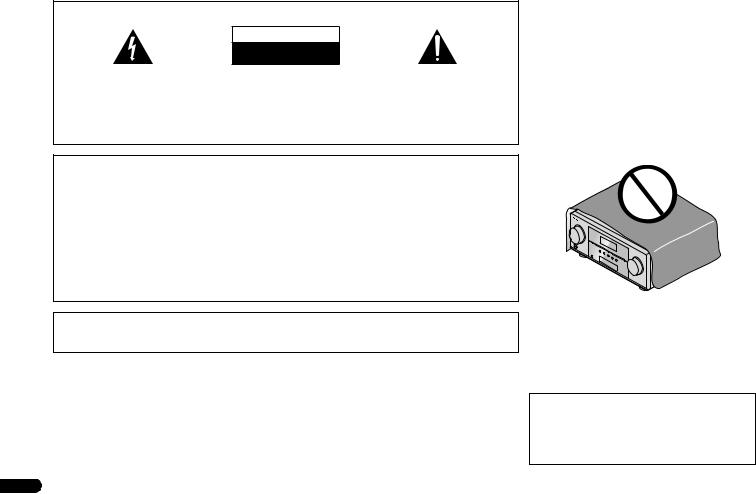
IMPORTANT
The lightning flash with arrowhead symbol, within an equilateral triangle, is intended to alert the user to the presence of uninsulated “dangerous voltage” within the product’s enclosure that may be of sufficient magnitude to constitute a risk of electric shock to persons.
CAUTION
RISK OF ELECTRIC SHOCK
DO NOT OPEN
CAUTION:
TO PREVENT THE RISK OF ELECTRIC SHOCK, DO NOT REMOVE COVER (OR BACK). NO USER-SERVICEABLE PARTS INSIDE. REFER SERVICING TO QUALIFIED SERVICE PERSONNEL.
The exclamation point within an equilateral triangle is intended to alert the user to the presence of important operating and maintenance (servicing) instructions in the literature accompanying the appliance.
D3-4-2-1-1_A1_En
NOTE:
This equipment has been tested and found to comply with the limits for a Class B digital device, pursuant to Part 15 of the FCC Rules. These limits are designed to provide reasonable protection against harmful interference in a residential installation. This equipment generates, uses, and can radiate radio frequency energy and, if not installed and used in accordance with the instructions, may cause harmful interference to radio communications. However, there is no guarantee that interference will not occur in a particular installation. If this equipment does cause harmful interference to radio or television reception, which can be determined by turning the equipment off and on, the user is encouraged to try to correct the interference by one or more of the following measures:
—Reorient or relocate the receiving antenna.
—Increase the separation between the equipment and receiver.
—Connect the equipment into an outlet on a circuit different from that to which the receiver is connected.
—Consult the dealer or an experienced radio/TV technician for help.
D8-10-1-2_A1_En
Information to User
Alterations or modifications carried out without appropriate authorization may invalidate the user’s right to operate the equipment.
WARNING
This equipment is not waterproof. To prevent a fire or shock hazard, do not place any container filled with liquid near this equipment (such as a vase or flower pot) or expose it to dripping, splashing, rain or moisture.
WARNING
To prevent a fire hazard, do not place any naked flame sources (such as a lighted candle) on the equipment.
D3-4-2-1-7a_A1_En
2
WARNING
Before plugging in for the first time, read the following section carefully.
The voltage of the available power supply differs according to country or region. Be sure that the power supply voltage of the area where this unit will be used meets the required voltage (e.g., 230 V or 120 V) written on the rear panel.
D3-4-2-1-4*_A1_En
VENTILATION CAUTION
When installing this unit, make sure to leave space around the unit for ventilation to improve heat radiation (at least 40 cm at top, 20 cm at rear, and 20 cm at each side).
WARNING
Slots and openings in the cabinet are provided for ventilation to ensure reliable operation of the product, and to protect it from overheating. To prevent fire hazard, the openings should never be blocked or covered with items (such as newspapers, table-cloths, curtains) or by operating the equipment on thick carpet or a bed.
D3-4-2-1-7b*_A1_En
Operating Environment
Operating environment temperature and humidity: +5 °C to +35 °C (+41 °F to +95 °F); less than 85 %RH (cooling vents not blocked)
Do not install this unit in a poorly ventilated area, or in locations exposed to high humidity or direct sunlight (or strong artificial light)
Caution
To prevent fire hazard, the Class 2 Wiring Cable should be used for connection with speaker, and should be routed away from hazards to avoid damage to the insulation of the cable.
D3-7-13-67*_A1_En
En
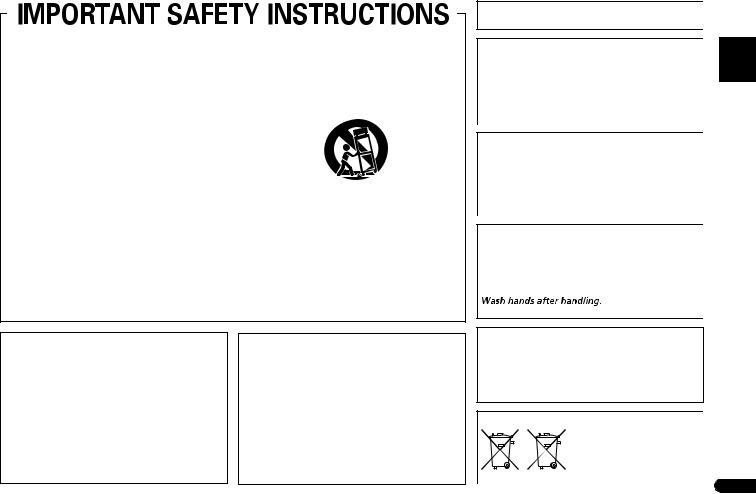
1)Read these instructions.
2)Keep these instructions.
3)Heed all warnings.
4)Follow all instructions.
5)Do not use this apparatus near water.
6)Clean only with dry cloth.
7)Do not block any ventilation openings. Install in accordance with the manufacturer’s instructions.
8)Do not install near any heat sources such as radiators, heat registers, stoves, or other apparatus (including amplifiers) that produce heat.
9)Do not defeat the safety purpose of the polarized or grounding-type plug. A polarized plug has two blades with one wider than the other. A grounding type plug has two blades and a third grounding prong. The wide blade or the third prong are provided for your safety. If the provided plug does not fit into your outlet, consult an electrician for replacement of the obsolete outlet.
10)Protect the power cord from being walked on or pinched particularly at plugs, convenience receptacles, and the point where they exit from the apparatus.
11)Only use attachments/accessories specified by the manufacturer.
12)Use only with the cart, stand, tripod, bracket, or table specified by the manufacturer, or sold with the apparatus. When a cart is used, use caution when moving the cart/apparatus combination to avoid injury from tip-over.
13)Unplug this apparatus during lightning storms or when unused for long periods of time.
14)Refer all servicing to qualified service personnel. Servicing is required when the apparatus has been damaged in any way, such as power-supply cord or plug is damaged, liquid has been spilled or objects have fallen into the apparatus, the apparatus has been exposed to rain or moisture, does not operate normally, or has been dropped.
D3-7-13-69_En
If the AC plug of this unit does not match the AC outlet you want to use, the plug must be removed and appropriate one fitted. Replacement and mounting of an AC plug on the power supply cord of this unit should be performed only by qualified service personnel. If connected to an AC outlet, the cut-off plug can cause severe electrical shock. Make sure it is properly disposed of after removal.
The equipment should be disconnected by removing the mains plug from the wall socket when left unused for a long period of time (for example, when on vacation).
D3-4-2-2-1a_A1_En
CAUTION
The STANDBY/ON switch on this unit will not completely shut off all power from the AC outlet. Since the power cord serves as the main disconnect device for the unit, you will need to unplug it from the AC outlet to shut down all power. Therefore, make sure the unit has been installed so that the power cord can be easily unplugged from the AC outlet in case of an accident. To avoid fire hazard, the power cord should also be unplugged from the AC outlet when left unused for a long period of time (for example, when on vacation).
STANDBY/ON switch on this unit will not completely shut off all power from the AC outlet. Since the power cord serves as the main disconnect device for the unit, you will need to unplug it from the AC outlet to shut down all power. Therefore, make sure the unit has been installed so that the power cord can be easily unplugged from the AC outlet in case of an accident. To avoid fire hazard, the power cord should also be unplugged from the AC outlet when left unused for a long period of time (for example, when on vacation).
D3-4-2-2-2a*_A1_En
This Class B digital apparatus complies with Canadian ICES-003.
CAUTION
This product satisfies FCC regulations when shielded cables and connectors are used to connect the unit to other equipment. To prevent electromagnetic interference with electric appliances such as radios and televisions, use shielded cables and connectors for connections.
IMPORTANT NOTICE
THE MODEL NUMBER AND SERIAL NUMBER OF THIS EQUIPMENT ARE ON THE REAR OR BOTTOM. RECORD THESE NUMBERS ON YOUR ENCLOSED WARRANTY CARD AND KEEP IN A SAFE PLACE FOR FUTURE REFERENCE.
D36-AP9-1_A1_En
WARNING: Handling the cord on this product or cords associated with accessories sold with the product may expose you to chemicals listed on proposition 65 known to the State of California and other governmental entities to cause cancer and birth defect or other reproductive harm.
D36-P5_B1_En
This product is for general household purposes. Any failure due to use for other than household purposes (such as long-term use for business purposes in a restaurant or use in a car or ship) and which requires repair will be charged for even during the warranty period.
(Symbol examples for batteries)
These symbols are only valid in the European Union.
Pb |
K058c_A1_En |
Español English
3
En

Thank you for buying this Pioneer product. Please read through these operating instructions so you will know how to operate your model properly. After you have finished reading the instructions, put them away in a safe place for future reference.
Contents
Before you start . . . . . . . . . . . . . . . . . . . . . . . . . . . . 5
Checking what’s in the box . . . . . . . . . . . . . . . . . . . . . . . . 5 Installing the receiver . . . . . . . . . . . . . . . . . . . . . . . . . . . . 5
Flow of settings on the receiver. . . . . . . . . . . . . . 5
01 Controls and displays
Front panel . . . . . . . . . . . . . . . . . . . . . . . . . . . . . . . . . . . . 6 Display . . . . . . . . . . . . . . . . . . . . . . . . . . . . . . . . . . . . . . 7 Remote control . . . . . . . . . . . . . . . . . . . . . . . . . . . . . . . . . 8 Loading the batteries . . . . . . . . . . . . . . . . . . . . . . . . . . . 9
Operating range of remote control . . . . . . . . . . . . . . . . . 9
02 Connecting your equipment
Determining the speakers’ application . . . . . . . . . . . . . . 10 Some tips for improving sound quality . . . . . . . . . . . . . 10
Connecting the speakers. . . . . . . . . . . . . . . . . . . . . . . . . 12
Switching the speaker terminal . . . . . . . . . . . . . . . . . . 12
Making cable connections . . . . . . . . . . . . . . . . . . . . . . . 13 HDMI cables . . . . . . . . . . . . . . . . . . . . . . . . . . . . . . . . 13 About HDMI. . . . . . . . . . . . . . . . . . . . . . . . . . . . . . . . . 13 Analog audio cables. . . . . . . . . . . . . . . . . . . . . . . . . . . 13 Digital audio cables . . . . . . . . . . . . . . . . . . . . . . . . . . . 13 Video cables. . . . . . . . . . . . . . . . . . . . . . . . . . . . . . . . . 14
About the video converter . . . . . . . . . . . . . . . . . . . . . . . . 14
Connecting a TV and playback components . . . . . . . . . . 15
Connecting using HDMI . . . . . . . . . . . . . . . . . . . . . . . 15
Connecting your TV with no HDMI input . . . . . . . . . . . 16 Connecting your DVD player with no HDMI output . . . 17
Connecting a satellite receiver or other digital
set-top box. . . . . . . . . . . . . . . . . . . . . . . . . . . . . . . . . . . . 18
Connecting an HDD/DVD recorder, Blu-ray Disc
recorder and other video sources . . . . . . . . . . . . . . . . . . 18 Using the component video jacks . . . . . . . . . . . . . . . . . . 19 Connecting other audio components . . . . . . . . . . . . . . . 19 Connecting optional Bluetooth® ADAPTER . . . . . . . . . . . 20 Connecting your SiriusConnect™ Tuner . . . . . . . . . . . . . 20
Connecting antennas . . . . . . . . . . . . . . . . . . . . . . . . . . . 20 Using external antennas . . . . . . . . . . . . . . . . . . . . . . . 21
Connecting to the front panel video terminal. . . . . . . . . . 21
4
Connecting an iPod . . . . . . . . . . . . . . . . . . . . . . . . . . . . 21 Connecting a USB device . . . . . . . . . . . . . . . . . . . . . . . . 22 Plugging in the receiver . . . . . . . . . . . . . . . . . . . . . . . . . 22
03 Basic Setup
Canceling the demo display . . . . . . . . . . . . . . . . . . . . . . 23
Automatically setting up for surround sound (MCACC). . . 23 Other problems when using the Auto MCACC setup . . . 24
04 Basic playback
Playing a source . . . . . . . . . . . . . . . . . . . . . . . . . . . . . . . 25
Selecting the audio input signal . . . . . . . . . . . . . . . . . 25
Playing an iPod. . . . . . . . . . . . . . . . . . . . . . . . . . . . . . . . 26
Playing back files stored on an iPod . . . . . . . . . . . . . . 27
Basic playback controls. . . . . . . . . . . . . . . . . . . . . . . . 27
Watching photos and video content . . . . . . . . . . . . . . 27
Playing a USB device . . . . . . . . . . . . . . . . . . . . . . . . . . . 27 Basic playback controls. . . . . . . . . . . . . . . . . . . . . . . . 28
Compressed audio compatibility . . . . . . . . . . . . . . . . . 28 Bluetooth® ADAPTER for Wireless Enjoyment
of Music . . . . . . . . . . . . . . . . . . . . . . . . . . . . . . . . . . . . . 28 Wireless music play . . . . . . . . . . . . . . . . . . . . . . . . . . 28
Pairing the Bluetooth ADAPTER and Bluetooth wireless technology device . . . . . . . . . . . . . . . . . . . . . . . . . . . . 29
Listening to Music Contents of Bluetooth wireless technology device with Your System . . . . . . . . . . . . . . 29
Listening to Satellite Radio . . . . . . . . . . . . . . . . . . . . . . . 29
Listening to SIRIUS Radio. . . . . . . . . . . . . . . . . . . . . . . . 30 Saving channel presets . . . . . . . . . . . . . . . . . . . . . . . . 30 Using the SIRIUS Menu. . . . . . . . . . . . . . . . . . . . . . . . 30 Listening to the radio . . . . . . . . . . . . . . . . . . . . . . . . . . . 31 Improving FM sound . . . . . . . . . . . . . . . . . . . . . . . . . . 31 Saving station presets . . . . . . . . . . . . . . . . . . . . . . . . . 31
Listening to station presets . . . . . . . . . . . . . . . . . . . . . 31
Naming preset stations . . . . . . . . . . . . . . . . . . . . . . . . 31
05 Listening to your system
Choosing the listening mode . . . . . . . . . . . . . . . . . . . . . 32
Auto playback . . . . . . . . . . . . . . . . . . . . . . . . . . . . . . . 32
Listening in surround sound . . . . . . . . . . . . . . . . . . . . 32 Using the Advanced surround . . . . . . . . . . . . . . . . . . 33
Using Stream Direct . . . . . . . . . . . . . . . . . . . . . . . . . . 33 Using the Sound Retriever . . . . . . . . . . . . . . . . . . . . . . . 33
Listening with Acoustic Calibration EQ. . . . . . . . . . . . . . 33 Better sound using Phase Control . . . . . . . . . . . . . . . . . 34 Using surround back channel processing . . . . . . . . . . . 34
Setting the Up Mix function . . . . . . . . . . . . . . . . . . . . . . 34 Setting the Audio options . . . . . . . . . . . . . . . . . . . . . . . . 35
Making an audio or a video recording. . . . . . . . . . . . . . . 36
06 The System Setup menu
Using the System Setup menu. . . . . . . . . . . . . . . . . . . . 37
Manual speaker setup . . . . . . . . . . . . . . . . . . . . . . . . . . 37 Speaker Setting . . . . . . . . . . . . . . . . . . . . . . . . . . . . . 37 Crossover Network . . . . . . . . . . . . . . . . . . . . . . . . . . . 38 Channel Level . . . . . . . . . . . . . . . . . . . . . . . . . . . . . . . 38 Speaker Distance . . . . . . . . . . . . . . . . . . . . . . . . . . . . 39
The Input Assign menu . . . . . . . . . . . . . . . . . . . . . . . . . 39 The Speaker System setting . . . . . . . . . . . . . . . . . . . . . . 40
The Video Parameter setting . . . . . . . . . . . . . . . . . . . . . 40
Video Converter . . . . . . . . . . . . . . . . . . . . . . . . . . . . . 40 Resolution . . . . . . . . . . . . . . . . . . . . . . . . . . . . . . . . . 40 Aspect . . . . . . . . . . . . . . . . . . . . . . . . . . . . . . . . . . . . 41 The Auto Power Down menu . . . . . . . . . . . . . . . . . . . . . 41 The FL Demo Mode menu . . . . . . . . . . . . . . . . . . . . . . . 41
07 Control with HDMI function
Making Control with HDMI connections . . . . . . . . . . . . 42
HDMI Setup . . . . . . . . . . . . . . . . . . . . . . . . . . . . . . . . . . 42
Before using synchronization. . . . . . . . . . . . . . . . . . . . . 43 About synchronized operations . . . . . . . . . . . . . . . . . . . 43 About connections with a product of a different brand
that supports the Control with HDMI function . . . . . . 43 Cautions on the Control with HDMI function . . . . . . . . . 43
08 Controlling the rest of your system
Setting the remote to control other components . . . . . . 44 Selecting preset codes directly . . . . . . . . . . . . . . . . . . . 44 Clearing all the remote control settings . . . . . . . . . . . . . 44
Controls for TVs . . . . . . . . . . . . . . . . . . . . . . . . . . . . . . . 45
Controls for other components . . . . . . . . . . . . . . . . . . . 45
Preset Code List . . . . . . . . . . . . . . . . . . . . . . . . . . . . . . . 45
09 Additional information
Troubleshooting . . . . . . . . . . . . . . . . . . . . . . . . . . . . . . . 48 General . . . . . . . . . . . . . . . . . . . . . . . . . . . . . . . . . . . . 48 HDMI . . . . . . . . . . . . . . . . . . . . . . . . . . . . . . . . . . . . . 49
Important information regarding the HDMI
connection . . . . . . . . . . . . . . . . . . . . . . . . . . . . . . . . . 50 iPod messages . . . . . . . . . . . . . . . . . . . . . . . . . . . . . . 50 USB messages . . . . . . . . . . . . . . . . . . . . . . . . . . . . . . 50 SIRIUS radio messages . . . . . . . . . . . . . . . . . . . . . . . 50 About iPod/iPhone/iPad. . . . . . . . . . . . . . . . . . . . . . . . . 50 Resetting the main unit . . . . . . . . . . . . . . . . . . . . . . . . . 50 Cleaning the unit . . . . . . . . . . . . . . . . . . . . . . . . . . . . . . 51 Specifications . . . . . . . . . . . . . . . . . . . . . . . . . . . . . . . . 51
En

Before you start
Checking what’s in the box
Please check that you’ve received the following supplied accessories:
•Setup microphone
•Remote control
•AAA size IEC R03 dry cell batteries (to confirm system operation) x2
•AM loop antenna
•FM wire antenna
•iPod cable
•These operating instructions
Installing the receiver
•When installing this unit, make sure to put it on a level and stable surface.
Don’t install it on the following places:
–on a color TV (the screen may distort)
–near a cassette deck (or close to a device that gives off a magnetic field). This may interfere with the sound.
–in direct sunlight
–in damp or wet areas
–in extremely hot or cold areas
–in places where there is vibration or other movement
–in places that are very dusty
–in places that have hot fumes or oils (such as a kitchen)
Flow of settings on the receiver
The unit is a full-fledged AV receiver equipped with an abundance of functions and terminals. It can be used easily after following the procedure below to make the connections and settings.
The colors of the steps indicate the following:
Required setting item
Setting to be made as necessary
1 Connecting the speakers
Where you place the speakers will have a big effect on the sound.
•Determining the speakers’ application (page 10)
•Connecting the speakers (page 12)
•Switching the speaker terminal (page 12)
2 Connecting the components
For surround sound, you’ll want to hook up using a digital connection from the Blu-ray Disc/DVD player to the receiver.
•About the video converter (page 14)
•Connecting a TV and playback components (page 15)
•Connecting antennas (page 20)
•Plugging in the receiver (page 22)
3 Power On
Make sure you’ve set the video input on your TV to this receiver. Check the manual that came with the TV if you don’t know how to do this.
4The Speaker System setting (page 40)
(Specify either using the surround back or front height speaker.)
The Input Assign menu (page 39)
(When using connections other than the recommended connections.)
Using the Audio Return Channel function (page 42)
(When the connected TV supports the HDMI Audio Return Channel function.)
5 Use the on-screen automatic MCACC setup to set up your system
•Automatically setting up for surround sound (MCACC) (page 23)
6Playing a source (page 25)
•Selecting the audio input signal (page 25)
•Playing an iPod (page 26)
•Playing a USB device (page 27)
•Choosing the listening mode (page 32)
7Adjusting the sound as desired
•Using the Sound Retriever (page 33)
•Better sound using Phase Control (page 34)
•Listening with Acoustic Calibration EQ (page 33)
•Using surround back channel processing (page 34)
•Setting the Up Mix function (page 34)
•Setting the Audio options (page 35)
•Manual speaker setup (page 37)
8Making maximum use of the remote control
•Setting the remote to control other components (page 44)
Español English
5
En

01 Controls and displays
Chapter 1:
Controls and displays
Front panel |
|
|
|
|
|
|
|
|
|
|
|
|
|
1 |
2 |
3 |
|
|
|
4 |
|
|
5 |
2 |
6 |
7 |
|
|
|
|
|
|
|
|
|
|
|
|
|
AUDIO/ VIDEO MULTICHANNEL RECEIVER VSX-921 |
|
|
MCACC |
|
|
|
|
|
|
|
|
HDMI iPod iPhone iPad |
|
16 |
17 |
|
|
|
|
|
|
|
|
|
|
|
|
||
|
SPEAKERS DIMMER |
DISPLAY |
BAND |
TUNER EDIT |
TUNE |
|
PRESET |
ENTER |
|
|
|
||
|
|
AUTO SURROUND/ |
ALC/ |
|
ADVANCED |
SOUND |
iPod iPhone iPad |
|
|
|
|
||
|
|
STREAM DIRECT |
STANDARD SURR |
SURROUND |
RETRIEVER AIR DIRECT CONTROL |
|
|
|
|
||||
INPUT |
|
|
|
|
|
|
|
|
|
|
|
MASTER |
|
SELECTOR |
|
|
|
|
|
|
|
|
|
|
|
VOLUME |
|
STANDBY/ON |
|
|
|
|
|
|
|
|
|
|
|
|
|
|
PHONES |
|
|
|
|
VIDEO 2 INPUT |
5V |
2.1 A |
|
|
|
|
23 |
|
|
|
|
|
|
|
|
|
|
22 |
|||
|
|
|
|
|
|
|
iPod |
USB |
|
|
|
||
|
|
|
MCACC |
|
|
iPhone |
|
|
|
|
|||
|
|
|
SETUP MIC |
L |
AUDIO R |
VIDEO iPad |
|
|
|
|
|
|
|
8 |
9 |
10 |
11 |
|
12 |
13 |
14 |
15 |
|
|
|
||
1 INPUT SELECTOR dial
Selects an input source (page 25).
2Indicators
MCACC – Lights when Acoustic Calibration EQ (page 33) is on (Acoustic Calibration EQ is automatically set to on after the Auto MCACC setup (page 23)).
HDMI – Blinks when connecting an HDMI-equipped component; lights when the component is connected (page 15).
iPod iPhone iPad – Lights when an iPod/iPhone/iPad is connected and iPod USB input is selected (page 21).
3Receiver control buttons
SPEAKERS – See Switching the speaker terminal on page 12.
DIMMER – Dims or brightens the display. The brightness can be controlled in four steps.
6
DISPLAY – Switches the display of this unit. The listening mode, sound volume, Speaker System setting or input name can be checked by selecting an input source.
•The Speaker System setting may or may not be displayed, depending on the input source you have selected.
4Character display
See Display on page 7.
5Tuner control buttons
BAND – Switches between AM, FM ST (stereo) and FM MONO radio bands (page 31).
TUNER EDIT – Use with TUNE /, PRESET / and
ENTER to memorize and name stations for recall (page 31). Used to preset the channel in SIRIUS Radio (page 30).
TUNE / – Used to find radio frequencies (page 31) and SIRIUS Radio channels (page 30).
18 19 20 18 21
24 |
25 |
26 |
27 26 |
28 |
PRESET / – Use to select preset radio stations (page 31) and to select SIRIUS Radio channels (page 30).
6 Remote sensor
Receives the signals from the remote control (see Operating range of remote control on page 9).
7MASTER VOLUME dial
8STANDBY/ON
9PHONES jack
Use to connect headphones. When the headphones are connected, there is no sound output from the speakers. The listening mode when the sound is heard from the headphone can be selected only from PHONES SURR, STEREO or STEREO ALC mode (S.R AIR mode can be also selected with
ADAPTER input).
En

Controls and displays |
0101 |
10Listening mode buttons
AUTO SURROUND/STREAM DIRECT – Switches between Auto surround mode (page 32) and Stream Direct playback (page 33).
ALC/STANDARD SURR – Press for standard decoding and to switch between the modes of 2Pro Logic II, 2 Pro Logic IIx, 2Pro Logic IIz and NEO:6, and the Auto level control stereo mode (page 32).
ADVANCED SURROUND – Switches between the various surround modes (page 33).
11MCACC SETUP MIC jack
Use to connect a microphone when performing Auto MCACC setup (page 23).
12 AUDIO/VIDEO input terminal
See Connecting to the front panel video terminal on page 21.
13 iPod iPhone iPad/USB terminal
Use to connect your Apple iPod or USB mass storage device as an audio source (page 21).
14 SOUND RETRIEVER AIR
When the button is pressed, the input switches to ADAPTER and the listening mode is automatically set to S.R AIR (page 29).
15 iPod iPhone iPad DIRECT CONTROL
Change the receiver’s input to the iPod and enable iPod operations on the iPod (page 27).
Display
16 PHASE
Lights when the Phase Control is switched on (page 34).
17 AUTO
Lights when the Auto Surround feature is switched on (page 32).
18Tuner/SIRIUS indicators
ST – Lights when a stereo FM broadcast is being received in auto stereo mode (page 31).
TUNE – Lights when a normal broadcast channel or SIRIUS channel is being received.
PRESET – Shows when a preset radio station is registered or called.
MEM – Blinks when a radio station is registered.
kHz/MHz – Lights when the character display is showing the currently received AM/FM broadcast frequency.
19 Speaker indicators
Indicates the speaker terminal, A and/or B, to which audio signal output is currently set (page 12).
20 Sleep timer indicator
Lights when the receiver is in sleep mode (page 8).
21PRESET information or input signal indicator
Shows the preset number of the tuner or the input signal type, etc.
22Character display
Displays various system information.
23DTS indicators
DTS – Lights when a source with DTS encoded audio signals is detected.
HD – Lights when a source with DTS-EXPRESS or DTSHD encoded audio signals is detected.
ES – Lights to indicate DTS-ES decoding.
96/24 – Lights when a source with DTS 96/24 encoded audio signals is detected.
NEO:6 – When one of the NEO:6 modes of the receiver is on, this lights to indicate NEO:6 processing (page 32).
24Dolby Digital indicators
2D – Lights when a Dolby Digital encoded signal is detected.
2D+ – Lights when a source with Dolby Digital Plus encoded audio signals is detected.
2HD – Lights when a source with Dolby TrueHD encoded audio signals is detected.
EX – Lights to indicate Dolby Digital EX decoding.
2PLII(x) – Lights to indicate 2Pro Logic II/2Pro Logic IIx decoding. Light will go off during 2Pro Logic IIz decoding (see Listening in surround sound on page 32 for more on this).
25ADV.S.
Lights when one of the Advanced Surround modes has been selected (see Using the Advanced surround on page 33 for more on this).
26SIGNAL SELECT indicators
DIGITAL – Lights when a digital audio signal is selected. Blinks when a digital audio signal is selected and selected audio input is not provided.
HDMI – Lights when an HDMI signal is selected. Blinks when an HDMI signal is selected and selected HDMI input is not provided.
27Up Mix/DIMMER indicator
Lights when the Up Mix function is set to ON (page 34). Also, lights when DIMMER is set to off.
28 DIR.
Lights when the DIRECT or PURE DIRECT mode is switched on (page 33).
Español English
7
En
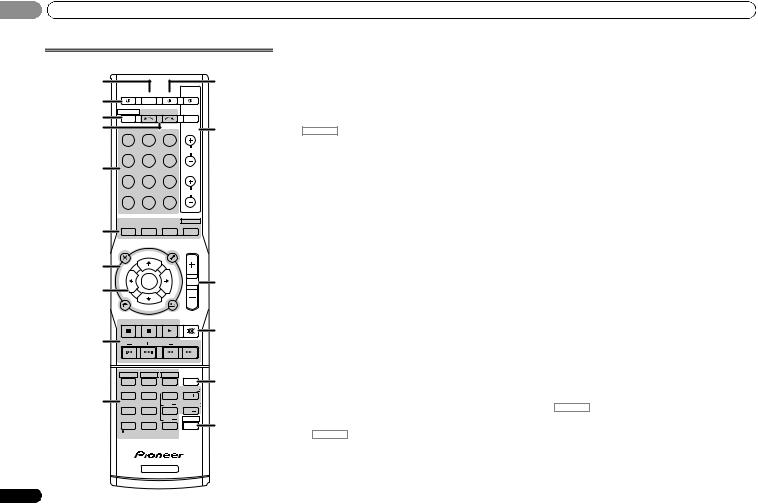
01 Controls and displays
Remote control
1 |
|
|
|
|
11 |
|
RECEIVER |
SLEEP |
SOURCE |
TV |
|
2 |
CONTROL |
|
|||
|
|
|
|
|
|
3 |
RECEIVER |
INPUT SELECT |
|
|
|
|
|
|
INPUT |
|
|
4 |
BD |
DVD |
TV |
|
12 |
|
DVR/BDR |
CD |
CD-R |
CH |
|
|
|
|
|||
5 |
ADAPTER iPod USB |
VIDEO1 |
|
|
|
|
VIDEO2 |
TUNER |
SIRIUS |
VOL |
|
|
AUTO/ |
|
ALC/ |
BD MENU |
|
6 |
DIRECT |
STEREO |
STANDARD |
ADV SURR |
|
|
|
|
|
|
|
|
AUDIO |
|
TUNER EDIT |
MASTER |
|
|
PARAMETER |
|
TOOLS |
VOLUME |
|
|
TOP |
TUNE |
MENU |
|
|
|
|
|
|
||
7 |
MENU |
|
|
|
|
|
T |
|
P |
|
|
|
E |
|
R |
|
13 |
|
S |
ENTER |
E |
|
|
|
E |
S |
|
||
8 |
R |
|
E |
|
|
P |
|
|
|||
|
|
T |
|
|
|
|
|
|
|
|
|
|
HOME |
|
|
|
|
|
MENU |
TUNE |
|
|
|
|
SETUP |
BAND |
|
||
|
|
|
|||
|
iPod CTRL |
|
RETURN |
|
|
|
CATEGORY |
|
DTV/ TV |
MUTE |
|
|
|
|
14 |
||
9 |
|
|
|
|
|
BASS |
TRE |
|
|||
|
|
|
|
MEMORY |
|
|
HDD |
DVD |
VCR |
|
15 |
|
1 |
2 |
3 |
DISP |
|
|
S.RETRIEVER |
SB CH |
CH SELECT |
EQ |
|
10 |
4 |
5 |
6 |
CH |
|
MIDNIGHT SPEAKERS |
LEV |
PHASE |
|
||
|
7 |
8 |
9 |
CH |
|
|
DIMMER SIGNAL SEL |
LEV |
SHIFT |
16 |
|
|
CLR |
0 |
ENTER |
|
|
|
/ +10 |
|
|
|
|
|
D.ACCESS |
|
|
|
|
|
|
RECEIVER |
|
|
|
8
1 SLEEP
Press to change the amount of time before the receiver switches into standby (30 min – 60 min – 90 min – Off). You can check the remaining sleep time at any time by pressing
SLEEP once.
2 RECEIVER
Switches the receiver between standby and on.
3 RECEIVER
Switches the remote to control the receiver (used to select the white commands above the number buttons (MIDNIGHT, etc)). Also use this button to set up surround sound (page 37) or Audio parameters (page 35).
4 INPUT SELECT 
Use to select the input source (page 25).
5 Input function buttons
Use to select the input source to this receiver (page 25). This will enable you to control other components with the remote control (page 44).
6Listening mode buttons
AUTO/DIRECT – Switches between Auto surround mode (page 32) and Stream Direct playback (page 33).
STEREO – Press to select stereo playback (page 32).
ALC/STANDARD SURR – Press for standard decoding and to switch between the modes of 2Pro Logic II, 2 Pro Logic IIx, 2Pro Logic IIz and NEO:6, and the Auto level control stereo mode (page 32).
ADV SURR – Switches between the various surround modes (page 33).
Press BD first to access:
BD MENU* – Displays the disc menu of Blu-ray Discs.
7 System Setup and component control buttons
The following button controls can be accessed after you have selected the corresponding input function button (BD, DVD, etc.).
Press RECEIVER first to access:
AUDIO PARAMETER – Use to access the Audio options (page 35).
SETUP – Press to access the System Setup menu (page 37).
RETURN – Confirm and exit the current menu screen. Press BD, DVD or DVR/BDR first to access:
TOP MENU – Displays the disc ‘top’ menu of a Blu-ray Disc/DVD.
HOME MENU – Displays the HOME MENU screen. RETURN – Confirm and exit the current menu screen.
MENU – Displays the TOOLS menu of Blu-ray Disc player. Press TUNER or SIRIUS first to access:
TUNER EDIT – Memorizes stations for recall (page 31). When TUNER is pressed, also used to change the name (page 31).
BAND – Switches between AM, FM ST (stereo) and FM MONO radio bands (page 31).
CATEGORY – Press to browse SIRIUS radio broadcasts. Press iPod USB first to access:
iPod CTRL – Switches between the iPod controls and the receiver controls (page 27).
8 / / / (TUNE /, PRESET /), ENTER
Use the arrow buttons when setting up your surround sound system (page 37). Also used to control Blu-ray Disc/DVD menus/options.
Use TUNE / can be used to find radio frequencies and PRESET / can be used to select preset radio stations (page 31).
9 Component control buttons
The main buttons ( , , etc.) are used to control a component after you have selected it using the input function buttons.
The controls above these buttons can be accessed after you have selected the corresponding input function button (BD, DVD, DVR/BDR and CD). These buttons also function as described below.
Press RECEIVER first to access:
BASS –/+, TRE –/+ – Use to adjust Bass or Treble.
•These controls are disabled when the listening mode is set to DIRECT or PURE DIRECT.
En
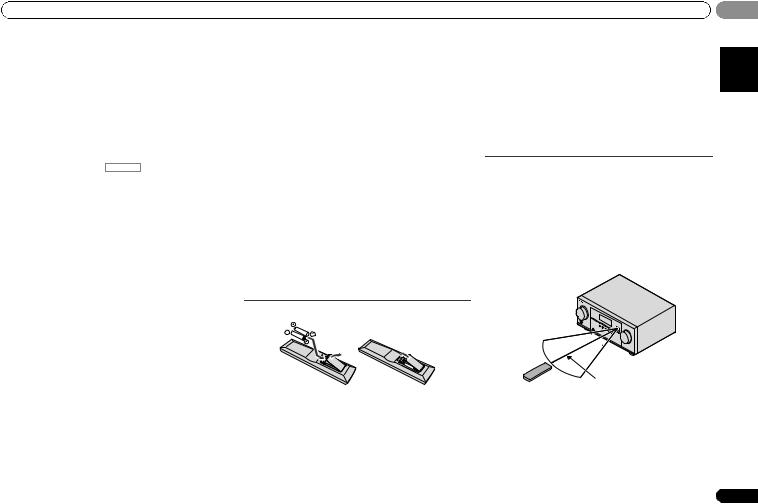
Controls and displays |
0101 |
•When the front speaker is set at SMALL in the Speaker Setting (or automatically via the Auto MCACC setup) and the Crossover Network is set above 150 Hz, the subwoofer channel level will be adjusted by pressing BASS –/+ (page 38).
Press TV first to access:
DTV/TV – Switches between the DTV and analog TV input modes for Pioneer TVs.
10 Number buttons and other component controls
Use the number buttons to directly select a radio frequency (page 31) or the tracks on a CD, etc. There are other buttons that can be accessed after RECEIVER is pressed. (For example MIDNIGHT, etc.)
HDD*, DVD*, VCR* – These buttons switch between the hard disk, DVD and VCR controls for HDD/DVD/VCR recorders.
S.RETRIEVER – Press to restore CD quality sound to compressed audio sources (page 33).
SB CH – Press to select ON, AUTO or OFF the surround back channel (page 34).
CH SELECT – Press repeatedly to select a channel, then use LEV +/– to adjust the level (page 38).
LEV +/– – Use to adjust the channel level.
EQ – Press to switch on/off Acoustic Calibration EQ setting (page 33).
MIDNIGHT – Switches to Midnight or Loudness listening (page 35).
SPEAKERS – See Switching the speaker terminal on page 12.
PHASE – Press to switch on/off Phase Control (page 34).
DIMMER – Dims or brightens the display. The brightness can be controlled in four steps.
SIGNAL SEL – Press to select the audio input signal of the component to play back (page 25).
Press SIRIUS first to access:
D.ACCESS – After pressing, you can access a radio station directly using the number buttons (page 30).
11 SOURCE
Press to turn on/off other components connected to the receiver (page 45).
12 TV CONTROL buttons
These buttons are dedicated to control the TV assigned to the TV button. Thus if you only have one TV to hook up to this system assign it to the TV button (page 45).
– Use to turn on/off the power of the TV. INPUT – Use to select the TV input signal.
CH +/– – Use to select channels.
VOL +/– – Use to adjust the volume on your TV.
13 MASTER VOLUME +/–
Use to set the listening volume.
14 MUTE
Mutes/unmutes the sound.
15 DISP
Switches the display of this unit. The listening mode, sound volume, Speaker System setting or input name can be checked by selecting an input source.
•The Speaker System setting may or may not be displayed, depending on the input source you have selected.
16 SHIFT
Press to access the ‘boxed’ commands (above the buttons) on the remote. These buttons are marked with an asterisk (*) in this section.
Loading the batteries
The batteries included with the unit are to check initial operations; they may not last over a long period. We recommend using alkaline batteries that have a longer life.
 CAUTION
CAUTION
•Incorrect use of batteries may result in such hazards as leakage and bursting. Observe the following precautions:
-Never use new and old batteries together.
-Insert the plus and minus sides of the batteries properly according to the marks in the battery case.
-Batteries with the same shape may have different voltages. Do not use different batteries together.
-When disposing of used batteries, please comply with governmental regulations or environmental public instruction’s rules that apply in your country or area.
-Do not use or store batteries in direct sunlight or other excessively hot place, such as inside a car or near a heater. This can cause batteries to leak, overheat, explode or catch fire. It can also reduce the life or performance of batteries.
Operating range of remote control
The remote control may not work properly if:
•There are obstacles between the remote control and the receiver’s remote sensor.
•Direct sunlight or fluorescent light is shining onto the remote sensor.
•The receiver is located near a device that is emitting infrared rays.
•The receiver is operated simultaneously with another infrared remote control unit.
30°  30°
30°
7 m (23 ft.)
Español English
9
En
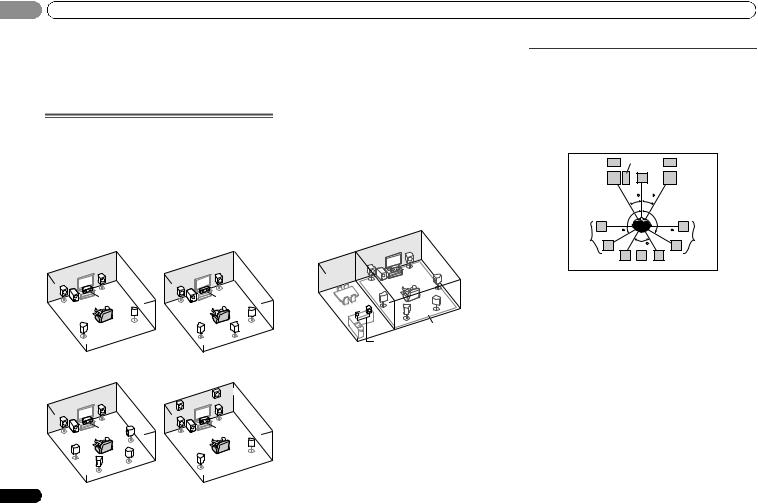
02 Connecting your equipment
Chapter 2:
Connecting your equipment
Determining the speakers’ application
By connecting the left and right front speakers (L/R), the center speaker (C), the left and right surround speakers (SL/ SR), the left and right surround back speakers (SBL/SBR) (or the left and right front height speakers (FHL/FHR)), and the subwoofer (SW), a surround sound system up to 7.1 channel can be enjoyed.
The 5.1 channel surround system is the most commonlyused in home theaters. To achieve the best possible surround sound, install your speakers as shown below.
5.1 channel surround |
|
6.1 channel surround |
||
system: |
|
(Surround back) system: |
||
R |
|
|
|
R |
L |
|
L |
|
|
C |
|
|
|
C |
SW |
|
SW |
|
|
|
SR |
|
|
SR |
SL |
|
|
SL |
SB |
|
|
|
||
7.1 channel surround |
|
7.1 channel surround |
||
(Surround back) system: |
(Front height) system: |
|||
R |
|
|
|
FHR |
|
FHL |
|
R |
|
|
|
|
||
L |
|
|
|
|
|
|
|
|
|
C |
SR |
L |
|
C |
|
|
|||
SW |
|
SW |
|
|
SL |
SBR |
|
|
SR |
|
|
|
||
SBL |
|
|
SL |
|
10
 Note
Note
•Both the surround back speakers and the front height speakers can be connected at the same time. In this case, sound will be output from either the front height speaker or the surround back speaker depending on which one was selected in the Speaker System setting (see The Speaker System setting on page 40).
Another way, you can use the speakers connected to the B speaker terminals to listen to stereo playback in another room. See Switching the speaker terminal on page 12 for the listening options with this setup.
•You will not be able to connect the B speakers if you connect the front height speakers in the main zone.
Further, if you use the B speakers, a 5.1 ch playback will be the maximum in the main zone. (No sound is output from the surround back speaker.)
R
L
Main zone
Speaker B
 Important
Important
•The Speaker System setting must be set if the above connections are performed. Select Surr.Back if the surround back speaker or speaker B is connected, and Height if the front height speaker is connected (see The Speaker System setting on page 40).
Some tips for improving sound quality
Where you put your speakers in the room has a big effect on the quality of the sound. The following guidelines should help you to get the best sound from your system.
•It is best to angle the speakers towards the listening position. The angle depends on the size of the room. Use less of an angle for bigger rooms.
•Refer to the chart below for placement of speakers you intend to connect.
FHL |
SW |
FHR |
|
|
C |
L |
|
R |
|
30 |
30 |
SL |
120 |
120 |
|
SR |
|
|
|
60 |
SBL SB SBR
-Place the surround speakers at 120º from the center. If you, (1) use the surround back speaker, and, (2) don’t use the front height speakers, we recommend placing the surround speaker right beside you.
-If you intend to connect only one surround back speakers, place it directly behind you.
-If the surround speakers cannot be set directly to the side of the listening position with a 7.1-channel system, the surround effect can be enhanced by turning off the Up Mix function (see Setting the Up Mix function on page 34).
•For the best stereo effect, place the front speakers 2 m to 3 m (6 ft. to 9 ft.) apart, at equal distance from the TV.
•If you’re using a center speaker, place the front speakers at a wider angle. If not, place them at a narrower angle.
•Place the center speaker above or below the TV so that the sound of the center channel is localized at the TV screen. Also, make sure the center speaker does not cross the line formed by the leading edge of the front left and right speakers.
En
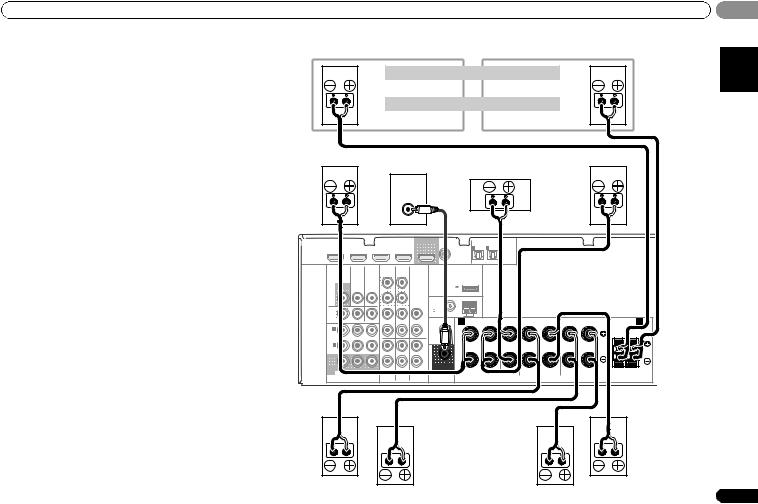
Connecting your equipment
•Surround and surround back speakers should be positioned 60 cm to 90 cm (2 ft. to 3 ft.) higher than your ears and titled slight downward. Make sure the speakers don’t face each other. For DVD-Audio, the speakers should be more directly behind the listener than for home theater playback.
•Try not to place the surround speakers farther away from the listening position than the front and center speakers. Doing so can weaken the surround sound effect.
•Place the left and right front height speakers at least one meter (3.3 ft.) directly above the left and right front speakers.
•If you’re going to place speakers around your CRT TV, use shielded speakers or place the speakers at a sufficient distance from your CRT TV.
•The subwoofer can be placed on the floor. Ideally, the other speakers should be at about ear-level when you’re listening to them. Putting the speakers on the floor (except the subwoofer), or mounting them very high on a wall is not recommended.
•When not connecting a subwoofer, connect speakers with low frequency reproduction capabilities to the front channel. (The subwoofer’s low frequency component is played from the front speakers, so the speakers could be damaged.)
•After connecting, be sure to conduct the Auto MCACC (speaker environment setting) procedure.
See Automatically setting up for surround sound (MCACC) on page 23.
 CAUTION
CAUTION
•Make sure that all speakers are securely installed. This not only improves sound quality, but also reduces the risk of damage or injury resulting from speakers being knocked over or falling in the event of external shocks such as earthquakes.
The front height terminals can also be used for Speaker B.
|
Front height setting |
Front height right |
Front height left |
|
Speaker B setting |
Speaker B - right |
Speaker B - left |
|
Front right |
|
Subwoofer |
|
|
|
|
|
|
|
Front left |
|
|||
|
|
|
|
|
|
|
Center |
|
|
|
|
|
|||
|
|
|
|
|
|
|
|
|
|
|
|
|
|
||
|
|
|
|
LINE LEVEL |
|
|
|
|
|
|
|
|
|
|
|
|
|
|
|
INPUT |
|
|
|
|
|
|
|
|
|
|
|
HDMI |
DVR/BDR IN |
DVD IN |
BD IN VIDEO 1 IN |
OUT COAXIAL |
|
IN |
IN |
OPTICAL |
|
|
|
|
|
||
|
|
|
|
|
|
IN 1 |
|
1 |
2 |
ASSIGNABLE |
|
|
|
|
|
|
|
|
|
|
|
ASSIGNABLE |
|
|
|
|
|
|
|
|
|
|
|
|
|
|
|
(CD) |
|
(TV/SAT) (CD-R/TAPE) |
|
|
|
|
|
||
|
VIDEO |
|
|
AUDIO |
|
|
|
|
|
|
|
|
|
|
|
|
|
|
|
DVR/BDR CD-R/TAPE |
|
|
|
|
|
|
|
|
|
|
|
|
MONITOR TV/SAT |
BD |
L |
|
ADAPTER PORT |
|
|
|
|
|
|
|
|||
|
|
|
(OUTPUT 5 V |
|
|
|
|
|
|
|
|
|
|||
|
OUT |
IN |
IN |
OUT |
|
0.1 A MAX) |
|
|
|
|
|
|
|
|
|
|
|
|
|
R |
|
ANTENNA |
|
|
|
|
|
|
|
|
|
|
DVR/ |
|
|
CD |
|
FM UNBAL |
|
|
|
|
|
|
|
|
|
|
|
|
|
|
|
|
|
|
|
|
|
|
|
||
|
BDR |
|
|
|
L |
75 |
|
|
|
|
|
|
|
|
|
|
|
|
|
|
|
AM LOOP |
|
|
|
|
|
|
|
|
|
|
OUT |
IN |
DVD IN |
IN |
IN |
SIRIUS |
A R |
FRONT |
CENTER |
SURROUND |
SURROUND BACK |
FRONT HEIGHT / |
B |
||
|
|
|
L |
R |
L |
R |
L(Single) |
|
|||||||
IN 1 |
|
|
|
|
|
R |
|
(DVD) |
|
|
|
|
|
R |
L |
ASSIGNABLE |
|
|
|
|
|
|
|
IN 2 |
|
|
|
|
|
L |
|
(DVR/ |
|
|
|
|
|
|
|
BDR) |
|
|
|
IN |
|
IN |
|
|
|
|
|
|
|
R |
|
MONITOR |
|
|
|
|
|
SUBWOOFER |
|
OUT |
Y |
PB |
PR |
TV/SAT |
BD |
DVD |
|
COMPONENT VIDEO |
PRE OUT |
SPEAKERS |
Class 2 Wiring |
When using only one surround back speaker, connect it to the
SURROUND BACK L (Single) terminals.
|
Surround |
Surround |
|
Surround right |
back right |
back left |
Surround left |
0202
Español English
11
En

02 Connecting your equipment
Connecting the speakers
The receiver will work with just two stereo speakers (the front speakers in the diagram) but using at least three speakers is recommended, and a complete setup is best for surround sound.
Make sure you connect the speaker on the right to the right (R) terminal and the speaker on the left to the left (L) terminal. Also make sure the positive and negative (+/–) terminals on the receiver match those on the speakers.
You can use speakers with a normal impedance between 6 Ω and 16 Ω.
Be sure to complete all connections before connecting this unit to the AC power source.
Bare wire connections
A-Speaker terminals:
1Twist exposed wire strands together.
2Loosen terminal and insert exposed wire.
3Tighten terminal.
1 |
2 |
3 |
10 mm (3/8 in.)
B-Speaker terminals:
1Twist exposed wire strands together.
2Push open the tabs and insert exposed wire.
3Release the tabs.
1 |
2 |
3 |
|
10 mm |
|
|
(3/8 in.) |
|
12
 CAUTION
CAUTION
•These speaker terminals carry HAZARDOUS LIVE voltage. To prevent the risk of electric shock when connecting or disconnecting the speaker cables, disconnect the power cord before touching any uninsulated parts.
•Make sure that all the bare speaker wire is twisted together and inserted fully into the speaker terminal. If any of the bare speaker wire touches the back panel it may cause the power to cut off as a safety measure.
Switching the speaker terminal
If you selected Surr.Back in The Speaker System setting on page 40, you can switch between speakers using the SPEAKERS button. If you selected Height, the button will simply switch your main speaker terminal on or off. The options below are for the Surr.Back setting only.
Use the SPEAKERS button on the front panel to select a speaker terminal setting.
SPEAKERS |
DIMMER |
DISPLAY |
|
|
|
|
|
|
|
|
|
Press repeatedly to choose a speaker terminal option:
•SP A – Sound is output from the speakers connected to the A-speaker terminals (multichannel playback is possible).
•SP B – Sound is output from the two speakers connected to the B-speaker terminals (only stereo playback is possible).
•SP AB – Sound is output from the A-speaker terminals, the two speakers in the B-speaker terminals, and the subwoofer. Multichannel sources are downmixed only when the STEREO or STEREO ALC mode is selected for stereo output from A- and B-speaker terminals.
•SP – No sound is output from the speakers.
 Note
Note
•The subwoofer output depends on the settings you made in Speaker Setting on page 37. However, if SP B is selected above, no sound is heard from the subwoofer (the LFE channel is not downmixed).
•All speaker terminals (except Speaker B connections) are switched off when headphones are connected.
En
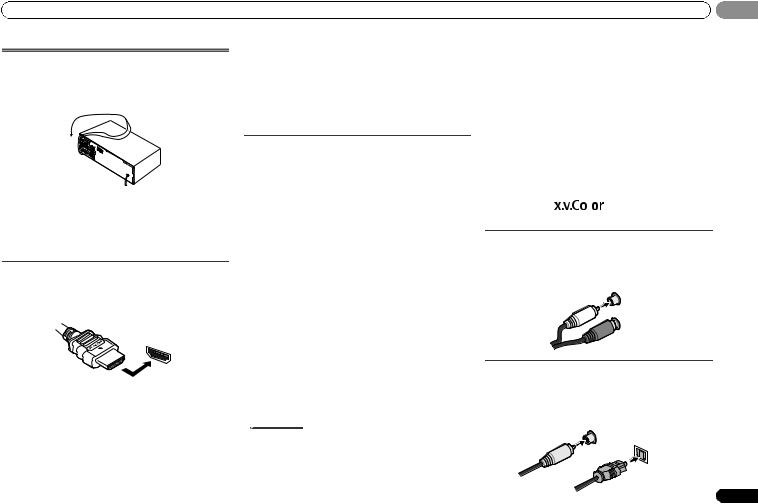
Connecting your equipment |
0202 |
Making cable connections
Make sure not to bend the cables over the top of this unit (as shown in the illustration). If this happens, the magnetic field produced by the transformers in this unit may cause a humming noise from the speakers.
 Important
Important
•Before making or changing connections, switch off the power and disconnect the power cord from the AC outlet.
•Before unplugging the power cord, switch the power into standby.
HDMI cables
Both video and sound signals can be transmitted simultaneously with one cable. If connecting the player and the TV via this receiver, for both connections, we recommend using HDMI cables.
HDMI
Be careful to connect the terminal in the proper direction.
 Note
Note
•Set the HDMI parameter in Setting the Audio options on page 35 to THRU (THROUGH) and set the input signal in
Selecting the audio input signal on page 25 to HDMI, if you want to hear HDMI audio output from your TV (no sound will be heard from this receiver).
•If the video signal does not appear on your TV, try adjusting the resolution settings on your component or display. Note that some components (such as video game units) have resolutions that may not be displayed. In this case, use a (analog) composite connection.
•When the video signal from the HDMI is 480i, 480p, 576i or 576p, Multi Ch PCM sound and HD sound cannot be received.
About HDMI
The HDMI connection transfers uncompressed digital video, as well as almost every kind of digital audio that the connected component is compatible with, including DVDVideo, DVD-Audio, SACD, Dolby Digital Plus, Dolby TrueHD, DTS-HD Master Audio (see below for limitations), Video CD/ Super VCD and CD.
This receiver incorporates High-Definition Multimedia Interface (HDMI®) technology.
This receiver supports the functions described below through HDMI connections.
•Digital transfer of uncompressed video (contents protected by HDCP (1080p/24, 1080p/60, etc.))
•3D signal transfer
•Deep Color signal transfer
•x.v.Color signal transfer
•Audio Return Channel
•Input of multi-channel linear PCM digital audio signals (192 kHz or less) for up to 8 channels
•Input of the following digital audio formats:
– Dolby Digital, Dolby Digital Plus, DTS, High bitrate audio (Dolby TrueHD, DTS-HD Master Audio), DVDAudio, CD, SACD (DSD 2 ch only), Video CD, Super VCD
•Synchronized operation with components using the Control with HDMI function (see Control with HDMI function on page 42)
 Note
Note
•Use a High Speed HDMI® cable. If HDMI cable other than a High Speed HDMI® cable is used, it may not work properly.
•When an HDMI cable with a built-in equalizer is connected, it may not operate properly.
• 3D, Deep Color, x.v.Color signal transfer and Audio |
|
English |
|
Return Channel are only possible when connected to a |
|
||
|
|
||
compatible component. |
|
|
|
• HDMI format digital audio transmissions require a longer |
|
|
|
time to be recognized. Due to this, interruption in the |
|
|
|
|
|
||
audio may occur when switching between audio formats |
|
||
Español |
|||
or beginning playback. |
|||
• Turning on/off the device connected to this unit’s HDMI |
|||
OUT terminal during playback, or disconnecting/ |
|||
connecting the HDMI cable during playback, may cause |
|
||
|
|||
noise or interrupted audio. |
|
||
HDMI, the HDMI Logo and High-Definition Multimedia Interface are trademarks or registered trademarks of HDMI Licensing, LLC in the United States and other countries.
“x.v.Color” and |
are trademarks of Sony |
Corporation.
Analog audio cables
Use stereo RCA phono cables to connect analog audio components. These cables are typically red and white, and you should connect the red plugs to R (right) terminals and white plugs to L (left) terminals.
White (Left)
L |
|
R |
AUDIO |
|
Red (Right)
Digital audio cables
Commercially available coaxial digital audio cables or optical cables should be used to connect digital components to this receiver.
Coaxial digital |
COAXIAL |
|
IN |
OPTICAL |
|
audio cable |
|
|
|
|
|
|
|
IN |
|
|
Optical cable |
13
En
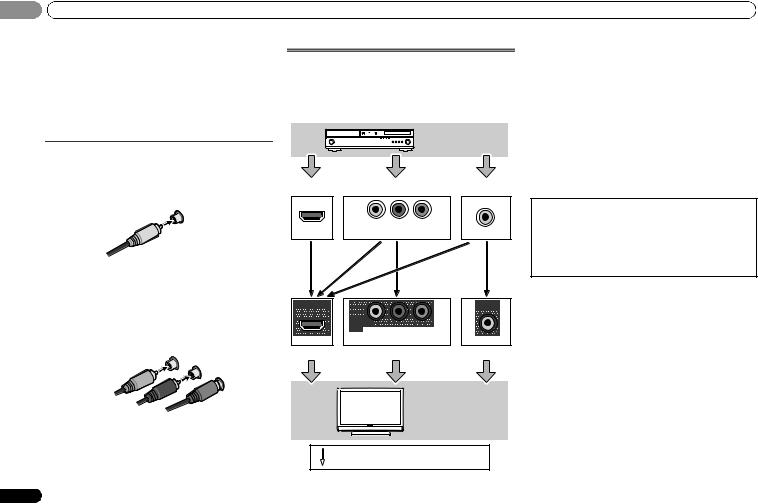
02 Connecting your equipment
 Note
Note
•When connecting optical cables, be careful when inserting the plug not to damage the shutter protecting the optical socket.
•When storing optical cable, coil loosely. The cable may be damaged if bent around sharp corners.
•You can also use a standard RCA video cable for coaxial digital connections.
Video cables
Standard RCA video cables
These cables are the most common type of video connection and are used to connect to the composite video terminals. The yellow plugs distinguish them from cables for audio.
VIDEO
Yellow
Component video cables
Use component video cables to get the best possible color reproduction of your video source. The color signal of the TV is divided into the luminance (Y) signal and the color (PB and PR) signals and then output. In this way, interference between the signals is avoided.
COMPONENT |
|
Y |
VIDEO |
PB |
|
Green (Y) |
PR |
|
About the video converter
The video converter ensures that all video sources are output from HDMI OUT terminal. The only exception is HDMI: since this resolution cannot be downsampled, you must connect your monitor/TV to the receiver’s HDMI video outputs when connecting this video source.
Playback component
Terminal for connection with source device
IN |
IN |
|
IN |
|
|
||
|
|
|
|
HDMI |
Y |
PB PR |
|
COMPONENT VIDEO |
VIDEO |
||
OUT |
|
|
MONITOR |
|
|
OUT |
|
|
|
|
|
|
MONITOR |
|
|
|
OUT Y |
PB PR |
|
HDMI |
COMPONENT VIDEO |
VIDEO |
|
Terminal for connection with TV monitor
Blue (PB) |
Red (PR) |
TV
 Video signals can be output.
Video signals can be output.
14
 Note
Note
•If several video components are assigned to the same input function, the converter gives priority to HDMI, component, then composite (in that order).
•If the video signal does not appear on your TV, try adjusting the resolution settings on your component or display. Note that some components (such as video game units) have resolutions that may not be converted. In this case, try switching Video Converter OFF (see Video Converter on page 40).
•The signal input resolutions that can be converted from the component video input for the HDMI output are 480i/ 576i, 480p/576p, 720p and 1080i. 1080p signal cannot be converted.
This product incorporates copyright protection technology that is protected by U.S. patents and other intellectual property rights. Use of this copyright protection technology must be authorized by Rovi Corporation, and is intended for home and other limited viewing uses only unless otherwise authorized by Rovi Corporation. Reverse engineering or disassembly is prohibited.
En
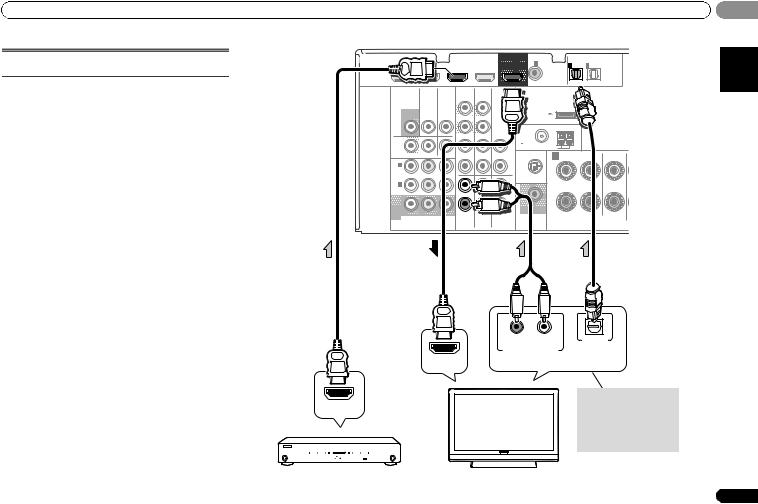
Connecting your equipment
Connecting a TV and playback components
Connecting using HDMI
If you have an HDMI or DVI (with HDCP) equipped component (Blu-ray Disc player, etc.), you can connect it to this receiver using a commercially available HDMI cable.
If the TV and playback components support the Control with HDMI feature, the convenient Control with HDMI functions can be used (see Control with HDMI function on page 42).
•The following connection/setting is required to listen to the sound of the TV over this receiver.
-If the TV does not support the HDMI Audio Return Channel function, connect the receiver and TV with audio cables (as shown).
-If the TV supports the HDMI Audio Return Channel function, the sound of the TV is input to the receiver via the HDMI terminal, so there is no need to connect an audio cable. In this case, set ARC at HDMI Setup to ON (see HDMI Setup on page 42).
|
|
|
|
|
|
|
|
|
|
|
|
|
|
|
0202 |
HDMI |
|
|
BD IN |
VIDEO 1 IN |
|
OUT |
COAXIAL |
|
|
IN |
IN |
OPTICAL |
English |
||
|
|
|
|
|
|
|
|
|
IN 1 |
|
|
1 |
2 |
ASSIGNABLE |
|
|
|
|
|
|
|
|
|
|
ASSIGNABLE |
|
|
|
|
||
|
|
|
|
|
|
|
|
|
(CD) |
|
|
(TV/SAT) (CD-R/TAPE) |
|
||
VIDEO |
|
|
AUDIO |
|
|
|
|
|
|
|
|
|
|
|
|
|
|
|
|
DVR/BDR CD-R/TAPE |
|
|
|
|
|
|
|
|
|
|
|
MONITOR TV/SAT |
BD |
|
L |
CD |
|
|
ADAPTER |
|
|
|
Español |
||||
|
|
|
|
OUTPUT 5 V |
|
|
|
|
|
||||||
|
OUT |
IN |
IN |
OUT |
|
|
|
|
.1 A MAX) |
|
|
|
|
|
|
|
|
|
|
|
R |
|
|
|
|
|
|
|
|
|
|
DVR/ |
|
|
|
|
|
|
|
FM UNBAL |
|
|
|
|
|
|
|
BDR |
|
|
|
|
|
|
L |
75 |
AM LOOP |
|
|
|
|
|
|
|
OUT |
IN |
DVD IN |
IN |
|
|
IN |
SIRIUS |
A |
|
FRONT |
CENTER |
|
||
|
|
|
|
|
|
|
|
|
|
|
R |
L |
|
|
|
IN 1 |
|
|
|
|
|
|
R |
|
|
|
|
|
|
|
|
(DVD) |
|
|
|
|
|
|
|
|
|
|
|
|
|
|
|
ASSIGNABLE |
|
|
|
|
|
|
|
IN |
|
|
|
|
|
|
|
IN 2 |
|
|
|
|
|
|
|
|
|
|
|
|
|
|
|
(DVR/ |
|
|
|
|
|
|
|
|
|
|
|
|
|
|
|
BDR) |
|
|
|
IN |
|
|
|
|
|
|
|
|
|
|
|
|
|
|
|
|
|
|
|
|
|
|
|
|
|
|
|
MONITOR |
|
|
|
|
|
|
|
SUBWOOFER |
|
|
|
|
|
|
|
OUT |
Y |
PB |
PR |
TV/SAT |
BD |
DVD |
|
|
|
|
|
|
|
|
|
COMPONENT VIDEO |
|
|
|
|
|
PRE OUT |
|
|
|
|
|
|
|||
R |
L |
OPTICAL |
ANALOG AUDIO OUT |
DIGITAL AUDIO OUT |
|
HDMI IN |
Select one |
|
If the TV does not support
HDMI OUT the HDMI Audio Return Channel function, this
connection is required to listen to the TV sound over the receiver.
|
|
|
|
|
|
|
|
|
|
|
|
|
|
|
|
|
|
|
|
|
|
|
|
HDMI/DVI-compatible |
|
|
|
|
|
|
|
||||
|
|
|
|
|
|
|
|||||
HDMI/DVI-compatible TV |
|||||||||||
Blu-ray Disc player |
|
|
|
|
|
|
|
||||
15
En
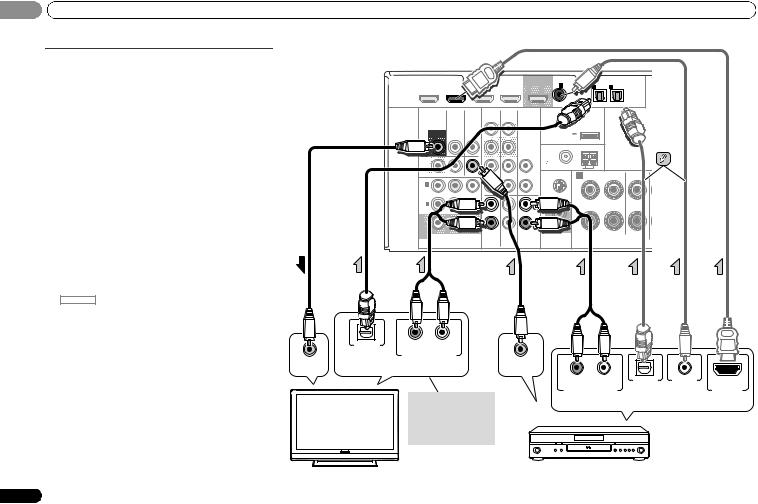
02 Connecting your equipment
Connecting your TV with no HDMI input
This diagram shows connections of a TV (with no HDMI input) and DVD player (or other playback component) to the receiver.
•With these connections, the picture is not output to the TV even if the DVD player is connected with an HDMI cable. Connect the DVD player’s video signals using a composite or component cable.
•Connect using an HDMI cable to listen to HD audio on the receiver. Do not use an HDMI cable to input video signals. Depending on the video component, it may not be possible to output signals connected by HDMI and other methods simultaneously, and it may be necessary to make output settings. Please refer to the operating instructions supplied with your component for more information.
•If both TV and player has a component video jacks, you can connect these too. See Using the component video jacks on page 19 for more on this.
 Note
Note
•In order to listen to the audio from the DVD player that is connected to this receiver using an optical cable or a coaxial cable, first, switch to the DVD input, then use RECEIVER and SIGNAL SEL to choose the audio signal O2 (OPTICAL2) or C1 (COAXIAL1) (see Selecting the audio input signal on page 25).
16
HDMI |
DVR/BDR IN |
DVD IN |
BD IN |
VIDEO 1 IN |
OUT |
COAXIAL |
|
IN |
IN |
OPTICAL |
|||
|
|
|
|
|
|
|
|
|
IN 1 |
|
1 |
2 |
ASSIGNABLE |
|
|
|
|
|
|
|
|
|
ASSIGNABLE |
|
|
||
|
|
|
|
|
|
|
|
|
(CD) |
|
(TV/SAT) (CD-R/TAPE) |
||
|
VIDEO |
|
|
AUDIO |
|
|
|
|
|
|
|
|
|
|
|
|
|
|
DVR/BDR CD-R/TAPE |
|
|
|
|
|
|
|
|
|
MONITOR TV/SAT |
BD |
|
L |
|
|
ADAPTER PORT |
|
|
||||
|
|
|
|
|
(OUTPUT 5 V |
|
|
|
|
||||
|
|
OUT |
IN |
IN |
OUT |
|
|
|
0.1 A MAX) |
|
|
|
|
|
|
|
|
|
|
R |
|
ANTENNA |
|
|
|
|
|
|
DVR/ |
|
|
|
|
|
CD |
FM UNBAL |
|
|
|
|
|
|
|
|
|
|
|
|
|
|
|
|
|||
|
BDR |
|
|
|
|
|
L |
75 |
AM LOOP |
|
|
|
|
|
|
OUT |
IN |
DVD IN |
IN |
|
IN |
SIRIUS |
A |
FRONT |
CENTER |
||
|
|
|
|
|
|
|
|
|
|
|
R |
L |
|
|
IN 1 |
|
|
|
|
|
R |
|
|
|
|
|
|
|
(DVD) |
|
|
|
|
|
|
|
|
|
|
|
|
|
ASSIGNABLE |
|
|
|
|
|
|
IN |
|
|
|
|
|
|
IN 2 |
|
|
|
|
|
L |
|
|
|
|
|
|
|
(DVR/ |
|
|
|
|
|
|
|
|
|
|
|
|
|
BDR) |
|
|
|
IN |
|
IN |
|
|
|
|
|
|
|
|
|
|
|
|
|
|
|
|
|
|
||
|
|
|
|
|
|
|
R |
|
|
|
|
|
|
|
MONITOR |
|
|
|
|
|
|
SUBWOOFER |
|
|
|
|
|
|
OUT |
Y |
PB |
PR |
TV/SAT |
BD |
DVD |
|
|
|
|
|
|
|
COMPONENT VIDEO |
|
|
|
|
PRE OUT |
|
|
|
|
|||
|
OPTICAL |
R |
L |
|
|
|
|
|
DIGITAL AUDIO OUT |
ANALOG AUDIO OUT |
|
|
|
|
|
VIDEO IN |
Select one |
VIDEO OUT |
|
|
|
|
|
|
|
|
R |
L |
OPTICAL |
COAXIAL |
|
|
|
|
ANALOG AUDIO OUT |
DIGITAL AUDIO OUT |
HDMI OUT |
||
|
|
This connection is |
|
Select one |
|
|
|
|
|
required in order to |
|
|
|
||
|
|
|
|
|
|
||
|
|
listen to the sound of |
|
|
|
|
|
|
|
the TV over the |
|
|
|
|
|
|
|
receiver. |
|
|
|
|
|
TV |
|
|
DVD player |
|
|
|
|
|
|
|
|
|
|
|
|
En
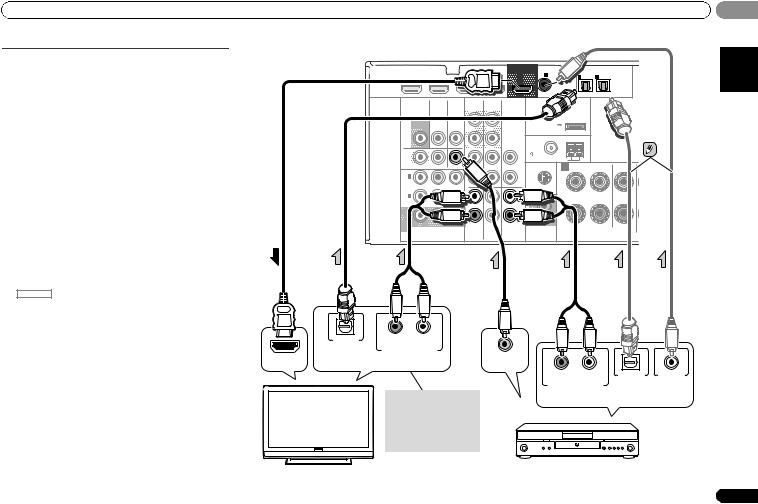
Connecting your equipment |
0202 |
Connecting your DVD player with no HDMI output
This diagram shows connections of a TV (with HDMI input) and DVD player (or other playback component with no HDMI output) to the receiver.
•If your player has a component video output, you can connect these too. See Using the component video jacks on page 19 for more on this.
•The following connection/setting is required to listen to the sound of the TV over this receiver.
-If the TV does not support the HDMI Audio Return Channel function, connect the receiver and TV with audio cables (as shown).
-If the TV supports the HDMI Audio Return Channel function, the sound of the TV is input to the receiver via the HDMI terminal, so there is no need to connect an audio cable. In this case, set ARC at HDMI Setup to ON (see HDMI Setup on page 42).
 Note
Note
•In order to listen to the audio from the DVD player that is connected to this receiver using an optical cable or a coaxial cable, first, switch to the DVD input, then use RECEIVER and SIGNAL SEL to choose the audio signal O2 (OPTICAL2) or C1 (COAXIAL1) (see Selecting the audio input signal on page 25).
HDMI |
DVR/BDR IN |
DVD IN |
|
|
IN |
OUT |
COAXIAL |
|
|
IN |
OPTICAL |
English |
||
|
|
|
|
|
|
|
|
|
IN 1 |
|
|
2 |
ASSIGNABLE |
|
|
|
|
|
|
|
|
|
|
|
|
|
TV/SAT) (CD-R/TAPE) |
|
|
|
VIDEO |
|
|
AUDIO |
|
|
|
|
|
|
|
|
Español |
|
|
|
|
|
|
DVR/BDR CD-R/TAPE |
|
|
|
|
|
|
|
||
|
MONITOR TV/SAT |
BD |
|
L |
|
|
|
|
PORT |
|
|
|||
|
|
|
|
|
(OUTPUT 5 V |
|
|
|
|
|
||||
|
|
OUT |
IN |
IN |
OUT |
|
|
|
0.1 A MAX) |
|
|
|
|
|
|
|
|
|
|
|
R |
|
ANTENNA |
|
|
|
|
|
|
|
DVR/ |
|
|
|
|
|
CD |
FM UNBAL |
|
|
|
|
|
|
|
|
|
|
|
|
|
|
|
|
|
|
|||
|
BDR |
|
|
|
|
|
L |
75 |
AM LOOP |
|
|
|
|
|
|
|
|
|
|
|
|
|
|
|
|
|
|
||
|
|
OUT |
IN |
DVD |
|
|
IN |
SIRIUS |
A |
R |
FRONT |
CENTER |
|
|
|
|
|
|
|
|
|
|
|
|
|
L |
|
|
|
|
IN 1 |
|
|
|
|
|
R |
|
|
|
|
|
|
|
|
(DVD) |
|
|
|
|
|
|
|
|
|
|
|
|
|
|
ASSIGNABLE |
|
|
|
|
|
|
|
|
|
|
|
|
|
|
IN 2 |
|
|
|
|
|
|
|
|
|
|
|
|
|
|
(DVR/ |
|
|
|
|
|
|
|
|
|
|
|
|
|
|
BDR) |
|
|
|
|
|
|
|
|
|
|
|
|
|
|
MONITOR |
|
|
|
|
|
|
|
|
|
|
|
|
|
|
OUT |
Y |
PB |
PR |
TV/SAT |
BD |
DVD |
|
|
|
|
|
|
|
|
COMPONENT VIDEO |
|
|
|
|
PRE OUT |
|
|
|
|
|
|||
|
OPTICAL |
R |
L |
|
DIGITAL AUDIO OUT ANALOG AUDIO OUT |
||
HDMI IN |
Select one |
|
VIDEO OUT |
If the TV does not support the HDMI Audio Return Channel function, this connection is required to listen to the TV sound over the receiver.
R |
L |
OPTICAL |
COAXIAL |
ANALOG AUDIO OUT |
DIGITAL AUDIO OUT |
||
|
Select one |
|
|
TV |
DVD player |
|
17
En
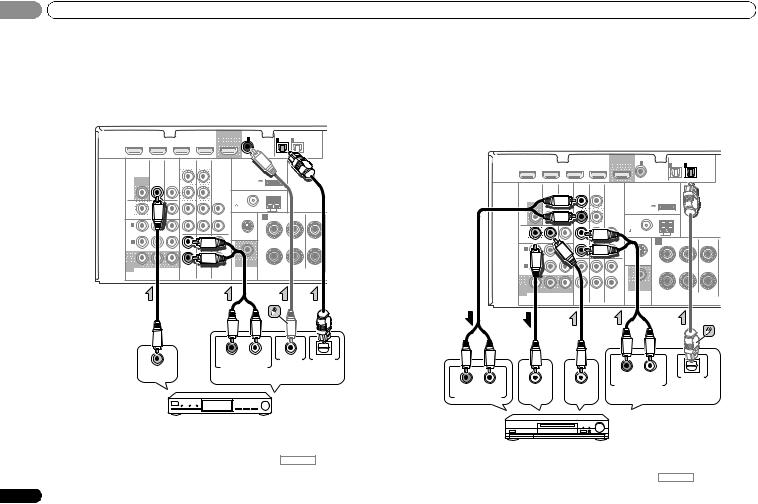
02 |
|
Connecting your equipment |
|
|
|
|
|
|
|
|
|
|
|
|
|
Connecting a satellite receiver or other digital set-top box |
Connecting an HDD/DVD recorder, Blu-ray Disc recorder and other |
||
|
Satellite and cable receivers, and terrestrial digital TV tuners are all examples of so-called ‘set- |
video sources |
||
|
top boxes’. |
This receiver has audio/video inputs and outputs suitable for connecting analog or digital |
||
|
|
• If the set-top box or video component also has an HDMI or a component video output, you |
||
|
|
video recorders, including HDD/DVD recorders and Blu-ray Disc recorders. |
||
can connect this too. See Connecting using HDMI on page 15 or Using the component |
• Only the signals that are input to the VIDEO IN terminal can be output from the VIDEO OUT |
|||||||||||
video jacks on page 19 for more on this. |
|
|
|
|
||||||||
|
|
|
|
terminal. |
|
|
|
|
||||
|
|
|
|
|
|
|
|
|
|
|
|
|
HDMI DVR/BDR IN DVD IN |
|
BD IN VIDEO 1 IN |
OUT COAXIAL |
|
|
OPTICAL |
• Audio signals that are input through the digital terminal will not be output from the analog |
|||||
|
IN |
IN |
terminal. |
|
|
|
|
|||||
|
|
|
|
IN 1 |
1 |
2 |
ASSIGNABLE |
|
|
|
|
|
|
|
|
|
ASSIGNABLE |
|
|
|
|
|
|
|
|
|
|
|
|
(CD |
TV/SAT |
|
|
HDMI DVR/BDR IN DVD IN |
BD IN VIDEO 1 IN OUT COAXIAL |
|
|
OPTICAL |
VIDEO |
|
|
AUDIO |
|
|
|
|
IN |
IN |
|||
|
|
|
DVR/BDR CD-R/TAPE |
|
|
|
|
|
IN 1 |
1 |
2 |
ASSIGNABLE |
|
|
|
|
|
|
|
|
ASSIGNABLE |
|
|
|
|
MONITOR TV/SAT |
BD |
L |
|
PORT |
|
|
|
(CD) |
(TV/SAT) (CD-R/TAPE) |
|||
|
(OUTPUT 5 V |
|
|
|
|
|||||||
OUT |
IN |
IN |
OUT |
0.1 A MAX) |
|
|
|
VIDEO |
AUDIO |
|
|
|
|
|
|
|
|
|
|
||||||
|
|
|
|
|
|
R |
ANTENNA |
|
|
|
|
|
|
|
DVR/BDR CD-R/TAPE |
|
|
|
|
|
|
|
|
|
|
|
|
|
|
|
|
|
|
|
|
|
|
|
ADAPTER PORT |
|
|||
DVR/ |
|
|
|
|
|
CD |
FM UNBAL |
|
|
|
MONITOR |
|
|
|
L |
|
|
||||
|
|
|
|
|
L |
|
|
|
|
|
|
|
|
(OUTPUT 5 V |
|
|
|
||||
BDR |
|
|
|
|
|
75 |
|
|
|
|
OUT |
|
|
OUT |
|
|
|
|
|
||
|
|
|
|
|
|
|
AM LOOP |
|
|
|
|
|
|
|
|
0.1 A MAX) |
|
|
|
||
|
OUT |
|
DVD IN |
IN |
|
IN |
SIRIUS |
A |
R |
FRONT |
CENTER |
|
|
|
|
R |
|
ANTENNA |
|
|
|
|
|
|
L |
|
|
|
|
|
|
|
|
|
|||||||||
IN 1 |
|
|
|
|
|
R |
|
|
|
|
DVR/ |
|
|
|
|
|
CD |
FM UNBAL |
|
|
|
(DVD) |
|
|
|
|
|
|
|
|
|
|
|
|
|
|
|
|
|
|
|||
ASSIGNABLE |
|
|
|
|
|
IN |
|
|
|
BDR |
|
|
|
|
|
L |
75 |
|
|
|
|
|
|
|
|
|
|
|
|
|
|
|
|
|
|
|
|
|
AM LOOP |
|
|
||
IN 2 |
|
|
|
|
|
L |
|
|
|
|
|
OUT |
IN |
|
|
|
IN |
SIRIUS |
A |
FRONT |
CENTER |
(DVR/ |
|
|
|
|
|
|
|
|
|
|
|
|
|
|
|
|
|
|
|
R |
L |
BDR) |
|
|
|
IN |
|
IN |
|
|
|
|
IN 1 |
|
|
|
|
|
R |
|
|
|
|
|
|
|
|
|
|
|
|
|
|
|
(DVD |
|
|
|
|
|
|
|
|
|
|
|
|
|
|
|
|
R |
SUBWOOFER |
|
|
|
|
|
|
|
|
|
|
IN |
|
|
|
MONITOR |
|
|
|
|
|
|
|
|
IN 2 |
|
|
|
|
|
L |
|
|
|
|
||
|
|
|
|
|
|
|
|
|
|
|
|
|
|
|
|
|
|
||||
OUT |
Y |
PB |
PR |
TV/SAT |
BD |
DVD |
|
|
|
|
(DVR/ |
|
|
|
|
|
|
|
|
|
|
COMPONENT VIDEO |
|
|
|
PRE OUT |
|
|
|
BDR) |
|
|
|
IN |
|
IN |
|
|
|
|
|||
|
|
|
|
|
|
|
|
|
|
|
|
|
|
|
|
|
|||||
|
|
|
|
|
|
|
|
|
|
|
|
|
|
|
|
|
R |
|
|
|
|
|
|
|
|
|
|
|
|
|
|
|
MONITOR |
|
|
|
|
|
SUBWOOFER |
|
|
|
|
|
|
|
|
|
|
|
|
|
|
|
OUT |
Y |
PB |
PR |
TV/SAT |
BD |
DVD |
|
|
|
|
|
|
|
|
|
|
|
|
|
|
|
COMPONENT VIDEO |
|
|
|
PRE OUT |
|
|
|
|||
R |
L |
COAXIAL |
OPTICAL |
ANALOG AUDIO OUT |
DIGITAL AUDIO OUT |
||
VIDEO OUT |
Select one |
|
|
Set-top box, etc.
 Note
Note
•In order to listen to the audio from the source component that is connected to this receiver using a coaxial cable, first, switch to the TV/SAT, then use RECEIVER and SIGNAL SEL to choose the audio signal C1 (COAXIAL1) (see Selecting the audio input signal on page 25).
18
|
|
|
R |
L |
OPTICAL |
R |
L |
|
ANALOG AUDIO OUT |
DIGITAL AUDIO OUT |
|
|
|
|
|
||
ANALOG AUDIO IN |
VIDEO IN |
VIDEO OUT |
Select one |
||
HDD/DVD recorder, Blu-ray
Disc recorder, etc.
 Note
Note
•In order to listen to the audio from the source component that is connected to this receiver using an optical cable, first, switch to the DVR/BDR input, then use RECEIVER and SIGNAL SEL to choose the audio signal O2 (OPTICAL2) (see Selecting the audio input signal on page 25).
En
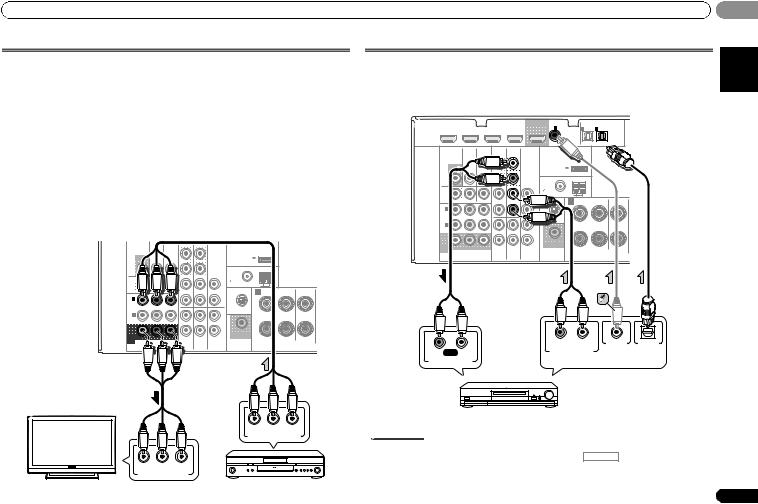
Connecting your equipment
Using the component video jacks
Component video should deliver superior picture quality when compared to composite video. A further advantage (if your source and TV are both compatible) is progressive-scan video, which delivers a very stable, flicker-free picture. See the manuals that came with your TV and source component to check whether they are compatible with progressive-scan video.
•For the audio connection, refer to Connecting your DVD player with no HDMI output on page 17.
 Important
Important
•If you connect any source component to the receiver using a component video input, you must also have your TV connected to this receiver’s COMPONENT VIDEO MONITOR OUT jacks.
•If necessary, assign the component video inputs to the input source you’ve connected. This only needs to be done if you didn’t connect according to the following defaults:
-COMPONENT VIDEO IN 1: DVD
-COMPONENT VIDEO IN 2: DVR/BDR
See The Input Assign menu on page 39 for more on this.
|
|
|
DVR/BDR CD-R/TAPE |
|
|
|
|
|
|
MONITOR TV/SAT |
BD |
|
L |
|
ADAPTER PORT |
|
|||
|
|
|
(OUTPUT 5 V |
|
|
|
|||
OUT |
IN |
IN |
OUT |
|
|
0.1 A MAX) |
|
|
|
|
|
|
|
R |
|
ANTENNA |
|
|
|
DVR/ |
|
|
|
|
CD |
FM UNBAL |
|
|
|
|
|
|
|
|
|
|
|
||
BDR |
|
|
|
|
L |
75 |
|
|
|
|
|
|
|
|
|
AM LOOP |
|
|
|
|
|
|
IN |
|
IN |
SIRIUS |
A |
FRONT |
CENTER |
|
|
|
|
R |
L |
||||
IN 1 |
|
|
|
|
R |
|
|
|
|
(DVD) |
|
|
|
|
|
|
|
|
|
ASSIGNABLE |
|
|
|
|
|
IN |
|
|
|
IN 2 |
|
|
|
|
L |
|
|
|
|
(DVR/ |
|
|
|
|
|
|
|
|
|
BDR) |
|
|
IN |
|
IN |
|
|
|
|
|
|
|
|
|
R |
|
|
|
|
MONITOR |
|
|
|
|
|
SUBWOOFER |
|
|
|
OUT |
|
|
TV/SAT |
BD |
DVD |
|
|
|
|
|
|
|
|
|
|
PRE OUT |
|
|
|
PR PB Y
COMPONENT VIDEO OUT
PR |
PB |
Y |
COMPONENT VIDEO IN |
||
TV |
|
DVD player |
0202
Connecting other audio components |
English |
|
|
The number and kind of connections depends on the kind of component you’re connecting. |
|
Follow the steps below to connect a CD-R, MD, DAT, tape recorder or other audio component. |
|
• Note that you must connect digital components to analog audio jacks if you want to record |
|
|||||||||||||
to/from digital components (like an MD) to/from analog components. |
Español |
|||||||||||||
HDMI |
DVR/BDR IN |
DVD IN |
|
BD IN |
VIDEO 1 IN |
OUT |
COAXIAL |
|
IN |
IN |
OPTICAL |
|||
|
|
|
|
|
|
|
|
|
IN 1 |
|
1 |
2 |
ASSIGNABLE |
|
|
|
|
|
|
|
|
|
|
ASSIGNABLE |
|
|
|
|
|
|
|
|
|
|
|
|
|
|
(CD) |
|
(TV/SAT) (CD-R/TAPE) |
|
||
|
VIDEO |
|
|
AUDIO |
|
|
|
|
|
|
|
|
|
|
|
|
|
|
|
DVR/BDR CD-R/TAPE |
|
|
|
|
|
|
|
|
|
|
MONITOR TV/SAT |
BD |
|
L |
|
|
ADAPTER PORT |
|
|
|
||||
|
|
|
|
|
(OUTPUT 5 V |
|
|
|
|
|
||||
|
|
OUT |
IN |
IN |
OUT |
|
|
|
0.1 A MAX) |
|
|
|
|
|
|
|
|
|
|
|
R |
|
ANTENNA |
|
|
|
|
|
|
|
DVR/ |
|
|
|
|
|
CD |
FM UNBAL |
|
|
|
|
|
|
|
|
|
|
|
|
|
|
|
|
|
|
|||
|
BDR |
|
|
|
|
|
L |
75 |
AM LOOP |
|
|
|
|
|
|
|
|
|
|
|
|
|
|
|
|
|
|
||
|
|
OUT |
IN |
DVD IN IN |
|
IN |
SIRIUS |
A R |
FRONT |
CENTER |
|
|||
|
|
|
|
L |
|
|
||||||||
|
IN 1 |
|
|
|
|
|
R |
|
|
|
|
|
|
|
|
(DVD) |
|
|
|
|
|
|
|
|
|
|
|
|
|
|
ASSIGNABLE |
|
|
|
|
|
|
IN |
|
|
|
|
|
|
|
IN 2 |
|
|
|
|
|
L |
|
|
|
|
|
|
|
|
(DVR/ |
|
|
|
|
|
|
|
|
|
|
|
|
|
|
BDR) |
|
|
|
IN |
|
IN |
|
|
|
|
|
|
|
|
|
|
|
|
|
|
R |
|
|
|
|
|
|
|
|
MONITOR |
|
|
|
|
|
|
SUBWOOFER |
|
|
|
|
|
|
|
OUT |
Y |
PB |
PR |
TV/SAT |
BD |
DVD |
|
|
|
|
|
|
|
|
COMPONENT VIDEO |
|
|
|
|
PRE OUT |
|
|
|
|
|
|||
|
|
R |
L |
COAXIAL |
OPTICAL |
R |
REC L |
ANALOG AUDIO OUT |
DIGITAL AUDIO OUT |
||
|
Select one |
|
|||
ANALOG AUDIO IN |
|
|
|||
CD-R, MD, DAT, Tape recorder, etc.
 Note
Note
•In order to listen to the audio from the CD player that is connected to this receiver using a coaxial cable, first, switch to the CD-R input, then use RECEIVER and SIGNAL SEL to choose the audio signal C1 (COAXIAL1) (see Selecting the audio input signal on page 25).
19
En
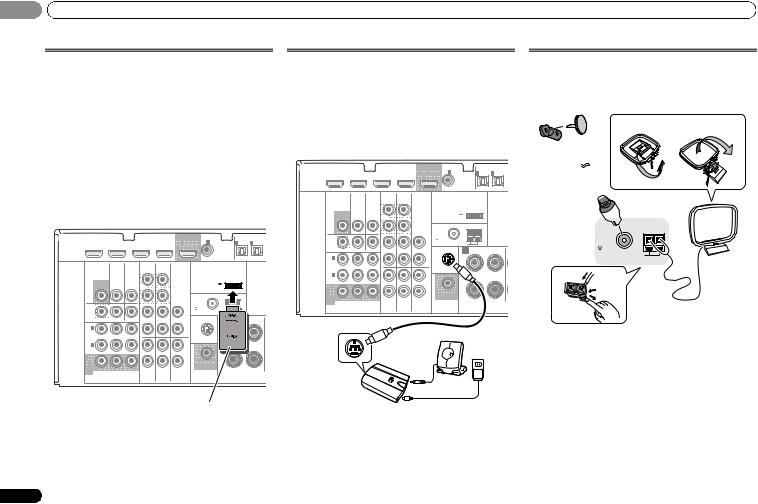
02 Connecting your equipment
Connecting optional Bluetooth® ADAPTER
When the Bluetooth ADAPTER (Pioneer Model No. AS-BT100 or AS-BT200) is connected to this unit, a product equipped with Bluetooth wireless technology (portable cell phone, digital music player, etc.) can be used to listen to music wirelessly.
Connect a Bluetooth ADAPTER to the ADAPTER PORT terminal on the rear panel.
•For instructions on playing the Bluetooth wireless technology device, see Pairing the Bluetooth ADAPTER and Bluetooth wireless technology device on page 29.
 Important
Important
•Do not move the receiver with the Bluetooth ADAPTER connected. Doing so could cause damage or faulty contact.
HDMI |
DVR/BDR IN |
DVD IN |
BD IN |
VIDEO 1 IN |
OUT |
COAXIAL |
IN |
IN |
O |
|||
|
|
|
|
|
|
|
|
|
IN 1 |
1 |
2 |
AS |
|
|
|
|
|
|
|
|
|
ASSIGNABLE |
|
|
|
|
|
|
|
|
|
|
|
|
(CD) |
(TV/SAT) (CD-R/TAP |
||
|
VIDEO |
|
|
AUDIO |
|
|
|
|
|
|
|
|
|
|
|
|
|
DVR/BDR CD-R/TAPE |
|
|
|
|
|
|
|
|
MONITOR TV/SAT |
BD |
|
L |
|
|
ADAPTER PORT |
|
|
|||
|
|
|
|
|
(OUTPUT 5 V |
|
|
|
||||
|
|
OUT |
IN |
IN |
OUT |
|
|
|
0.1 A MAX) |
|
|
|
|
|
|
|
|
|
R |
|
ANTENNA |
|
|
|
|
|
DVR/ |
|
|
|
|
|
CD |
FM UNBAL |
|
|
|
|
|
|
|
|
|
|
|
|
|
|
|||
|
BDR |
|
|
|
|
|
L |
75 |
AM |
|
|
|
|
|
|
|
|
|
|
|
|
|
|
|
|
|
|
OUT |
IN |
DVD IN |
IN |
|
IN |
SIRIUS |
|
L |
|
|
|
|
|
|
|
|
|
|
|
|
|
|
|
|
IN 1 |
|
|
|
|
|
R |
|
|
|
|
|
|
(DVD) |
|
|
|
|
|
|
|
|
|
|
|
|
ASSIGNABLE |
|
|
|
|
|
|
IN |
|
|
|
|
|
IN 2 |
|
|
|
|
|
L |
|
|
|
|
|
|
(DVR/ |
|
|
|
|
|
|
|
|
|
|
|
|
BDR) |
|
|
|
IN |
|
IN |
|
|
|
|
|
|
|
|
|
|
|
|
R |
|
|
|
|
|
|
MONITOR |
|
|
|
|
|
|
SUBWOOFER |
|
|
|
|
|
OUT |
Y |
PB |
PR |
TV/SAT |
BD |
DVD |
|
|
|
|
|
|
COMPONENT VIDEO |
|
|
|
|
PRE OUT |
|
|
|
|||
Bluetooth® ADAPTER
20
Connecting your SiriusConnect™ Tuner
To receive SIRIUS Satellite Radio broadcasts, you will need to activate your SiriusConnect tuner.
Connect a SiriusConnect tuner to the SIRIUS IN jack on the rear panel.
•You will also need to connect the antenna and AC adapter to the SiriusConnect tuner.
•For instructions on playing the SIRIUS Radio, see
Listening to SIRIUS Radio on page 30.
HDMI |
DVR/BDR IN |
DVD IN |
BD IN |
VIDEO 1 IN |
OUT |
COAXIAL |
|
IN |
IN |
OP |
||||
|
|
|
|
|
|
|
|
|
IN 1 |
|
|
1 |
2 |
ASS |
|
|
|
|
|
|
|
|
|
ASSIGNABLE |
|
|
|
||
|
|
|
|
|
|
|
|
|
(CD) |
|
|
(TV/SAT) (CD-R/TAPE |
||
|
VIDEO |
|
|
AUDIO |
|
|
|
|
|
|
|
|
|
|
|
|
|
|
|
DVR/BDR CD-R/TAPE |
|
|
|
|
|
|
|
|
|
|
MONITOR TV/SAT |
BD |
|
L |
|
|
ADAPTER PORT |
|
|
|||||
|
|
|
|
|
(OUTPUT 5 V |
|
|
|
|
|
||||
|
|
OUT |
IN |
IN |
OUT |
|
|
|
0.1 A MAX) |
|
|
|
|
|
|
|
|
|
|
|
R |
|
ANTENNA |
|
|
|
|
|
|
|
DVR/ |
|
|
|
|
|
CD |
FM UNBAL |
|
|
|
|
|
|
|
|
|
|
|
|
|
|
|
|
|
|
|||
|
BDR |
|
|
|
|
|
L |
75 |
AM LOOP |
|
|
|
|
|
|
|
|
|
|
|
|
|
|
|
|
|
|
||
|
|
OUT |
IN |
DVD IN |
IN |
|
IN |
SIRIUS |
A |
R |
FRONT |
|
||
|
|
|
|
|
|
|
|
|
|
|
|
L |
|
|
|
IN 1 |
|
|
|
|
|
R |
|
|
|
|
|
|
|
|
(DVD) |
|
|
|
|
|
|
|
|
|
|
|
|
|
|
ASSIGNABLE |
|
|
|
|
|
|
IN |
|
|
|
|
|
|
|
IN 2 |
|
|
|
|
|
L |
|
|
|
|
|
|
|
|
(DVR/ |
|
|
|
|
|
|
|
|
|
|
|
|
|
|
BDR) |
|
|
|
IN |
|
IN |
|
|
|
|
|
|
|
|
|
|
|
|
|
|
R |
|
|
|
|
|
|
|
|
MONITOR |
|
|
|
|
|
|
SUBWOOFER |
|
|
|
|
|
|
|
OUT |
Y |
PB |
PR |
TV/SAT |
BD |
DVD |
|
|
|
|
|
|
|
|
COMPONENT VIDEO |
|
|
|
|
PRE OUT |
|
|
|
|
|
|||
|
|
|
|
|
|
Antenna |
|
|
|
|
|
|
||
|
|
|
|
|
|
|
|
|
SIRIUS |
|
|
|
|
|
|
|
|
|
SIRIUS |
|
|
|
|
|
|
|
|
|
|
SiriusConnect™ |
|
|
|
|
|
|
|
|
|
|
|
|||
HOME tuner |
|
|
|
|
|
|
AC adapter |
|
||||||
|
|
|
|
|
|
|
|
|
|
|
||||
Connecting antennas
Connect the AM loop antenna and the FM wire antenna as shown below. To improve reception and sound quality, connect external antennas (see Using external antennas below).
fig. a |
fig. b |


 2 4
2 4 
ANTENNA |
FM UNBAL |
75 |
AM LOOP |
3
1
1Push open the tabs, then insert one wire fully into each terminal, then release the tabs to secure the AM antenna wires.
2Fix the AM loop antenna to the attached stand.
To fix the stand to the antenna, bend in the direction indicated by the arrow (fig. a) then clip the loop onto the stand (fig. b).
3Place the AM antenna on a flat surface and in a direction giving the best reception.
4Connect the FM wire antenna into the FM antenna socket.
For best results, extend the FM antenna fully and fix to a wall or door frame. Don’t drape loosely or leave coiled up.
En
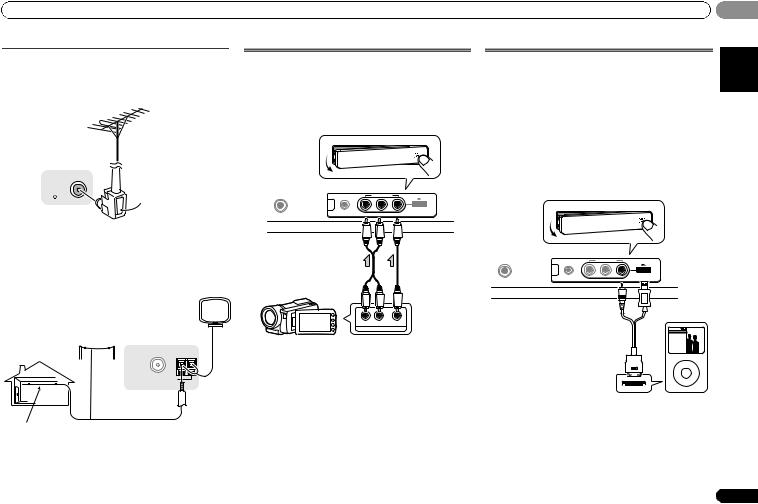
Connecting your equipment |
0202 |
Using external antennas
To improve FM reception
Use an F connector (not supplied) to connect an external FM antenna.
ANTENNA
FM UNBAL |
F connector |
75 |
To improve AM reception
Connect a 5 m to 6 m (16 ft. to 20 ft.) length of vinyl-coated wire to the AM antenna terminal without disconnecting the supplied AM loop antenna.
For the best possible reception, suspend horizontally outdoors.
Outdoor antenna
ANTENNA
FM UNBAL 75
AM LOOP
Indoor antenna |
5 m to 6 m |
(vinyl-coated wire) |
(16 ft. to 20 ft.) |
Connecting to the front panel video terminal
Front video connections are accessed via the front panel using the INPUT SELECTOR or VIDEO2 button on the remote control. There are standard audio/video jacks. Hook them up the same way you made the rear panel connections.
•Push down on the PUSH OPEN tab to access the front video connections.
PHONES |
VIDEO 2 INPUT |
5V |
2.1 A |
|
|
||
|
|
iPod |
USB |
MCACC |
|
iPhone |
|
SETUP MIC |
L AUDIO R |
VIDEO iPad |
|
This receiver
AUDIO VIDEO
OUTPUT
Video camera, etc.
Connecting an iPod
This receiver has a dedicated iPod terminal that will allow you to control playback of audio content from your iPod using the controls of this receiver.
Switch the receiver into standby, and then use the iPod cable to connect your iPod to the iPod terminal on the front panel of this receiver.
•Push down on the PUSH OPEN tab to access the iPod terminal.
•For the cable connection, refer to also the operating instructions for iPod.
•For instructions on playing the iPod, see Playing an iPod on page 26.
ON/OFF
PHONES |
VIDEO 2 INPUT |
5V |
2.1 A |
|
|
||
|
|
iPod |
USB |
MCACC |
|
iPhone |
|
SETUP MIC |
L AUDIO R |
VIDEO iPad |
|
This receiver
Music
Genius >
Playlists
iPod cable Artists
Albums
Songs
Radio
Genres
Composers
Audiobooks
MENU
iPod
Español English
21
En
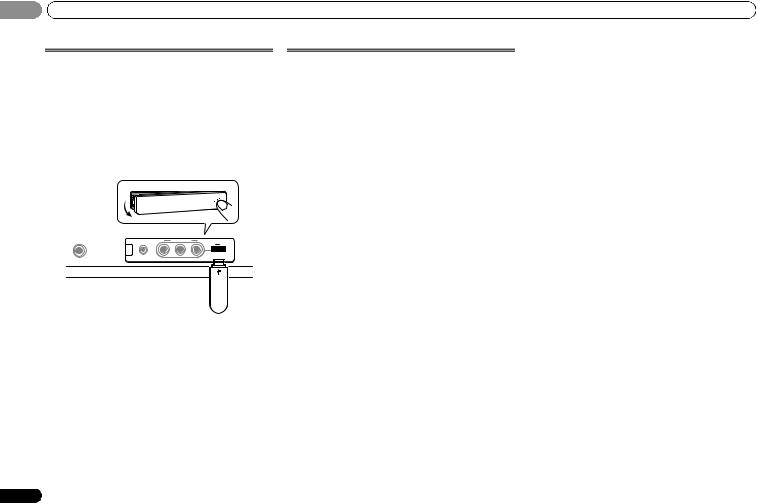
02 Connecting your equipment
Connecting a USB device
It is possible to listen to two-channel audio using the USB interface on the front of this receiver.
Switch the receiver into standby then connect your USB device to the USB terminal on the front panel of this receiver.
•Push down on the PUSH OPEN tab to access the USB terminal.
•This receiver does not support a USB hub.
•For instructions on playing the USB device, see Playing a USB device on page 27.
PHONES |
VIDEO 2 INPUT |
5V |
2.1 A |
|
|
||
|
|
iPod |
USB |
MCACC |
|
iPhone |
|
SETUP MIC |
L AUDIO R |
VIDEO iPad |
|
This receiver
USB mass storage device
Plugging in the receiver
Only plug in after you have connected all your components to this receiver, including the speakers.
Plug the AC power cord into a convenient AC power outlet.
 CAUTION
CAUTION
•Handle the power cord by the plug part. Do not pull out the plug by tugging the cord, and never touch the power cord when your hands are wet, as this could cause a short circuit or electric shock. Do not place the unit, a piece of furniture, or other object on the power cord or pinch the cord in any other way. Never make a knot in the cord or tie it with other cables. The power cords should be routed so that they are not likely to be stepped on. A damaged power cord can cause a fire or give you an electric shock. Check the power cord once in a while. If you find it damaged, ask your nearest Pioneer authorized independent service company for a replacement.
•The receiver should be disconnected by removing the mains plug from the wall socket when not in regular use, e.g., when on vacation.
 Note
Note
•After this receiver is connected to an AC outlet, a 2 second to 10 second HDMI initialization process begins. You cannot carry out any operations during this process. The HDMI indicator in the front panel display blinks during this process, and you can turn on this receiver once it has stopped blinking. When you set the Control with HDMI to OFF, you can skip this process. For details about the Control with HDMI feature, see Control with HDMI function on page 42.
22
En
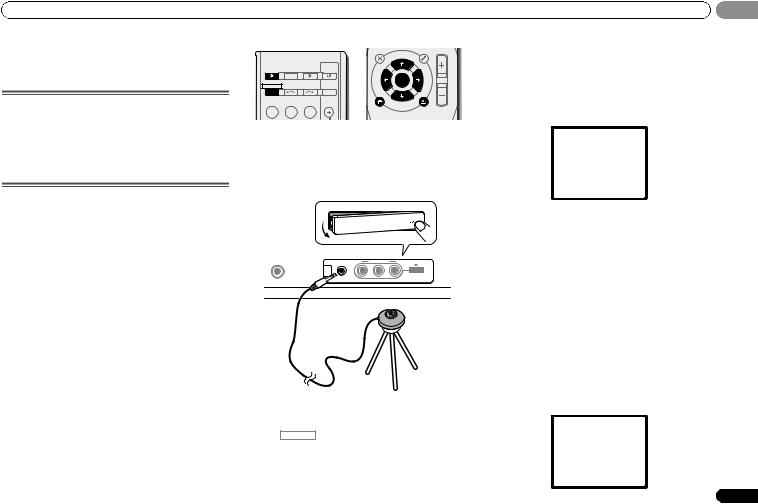
Basic Setup |
0303 |
Chapter 3:
Basic Setup
Canceling the demo display
The display on the front panel shows various information (demo displays) when the receiver is not operating.
You can turn off the demo display. For details, see The FL Demo Mode menu on page 41.
•The demo mode is canceled automatically when the Auto MCACC setup is performed (see below).
Automatically setting up for surround sound (MCACC)
The Auto Multi-Channel Acoustic Calibration (MCACC) setup measures the acoustic characteristics of your listening area, taking into account ambient noise, speaker size and distance, and tests for both channel delay and channel level. After you have set up the microphone provided with your system, the receiver uses the information from a series of test tones to optimize the speaker settings and equalization for your particular room.
 CAUTION
CAUTION
•The test tones used in the Auto MCACC setup are output at high volume.
 Important
Important
•The Auto MCACC setup will overwrite any existing speaker settings you’ve made.
•Before using the Auto MCACC setup, the iPod USB input should not be selected as an input source.
•When both the surround back speaker and the front height speaker are connected, conduct Auto MCACC setup twice: once with the Speaker System setting is in Surr.Back and once with the Speaker System setting is in Height. (There is no need to conduct Auto MCACC setup every time the Speaker System setting is changed.)
|
|
|
PARAMETER |
|
TOOLS VOLUME |
|
|
|
TOP |
TUNE |
MENU |
|
|
|
|
||
|
|
|
MENU |
|
|
RECEIVER |
SLEEP |
TV |
|
|
|
SOURCE CONTROL |
T |
|
|
||
|
|
|
|
P |
|
|
|
|
E |
|
R |
|
|
|
S |
ENTER |
E |
|
|
|
E |
S |
|
|
|
|
P |
|
E |
RECEIVER |
INPUT SELECT |
R |
|
T |
|
|
|
||||
|
|
INPUT |
|
|
|
|
|
|
HOME |
|
|
BD |
DVD |
TV |
MENU |
T UNE |
|
SETUP |
BAND |
||||
|
|
|
iPod CTRL |
|
RETURN |
CATEGORY
DTV/ TV MUTE
1Switch on the receiver and your TV.
2Switch the TV input so that it connects to the receiver.
3Connect the microphone to the MCACC SETUP MIC jack on the front panel.
Make sure there are no obstacles between the speakers and the microphone.
PHONES |
VIDEO 2 INPUT |
5V |
2.1 A |
|
|
||
|
|
iPod |
USB |
MCACC |
|
iPhone |
|
SETUP MIC |
L AUDIO R |
VIDEO iPad |
|
Microphone
Tripod
If you have a tripod, use it to place the microphone so that it’s about ear level at your normal listening position. Otherwise, place the microphone at ear level using a table or a chair.
4 Press RECEIVER on the remote control, then press the
SETUP button.
The System Setup menu appears on your TV. Use / / / and ENTER on the remote control to navigate through the screens and select menu items. Press RETURN to exit the current menu.
• Press SETUP at any time to exit the System Setup menu. |
English |
||||
If you cancel the Auto MCACC setup at any time, the |
|||||
|
|||||
receiver automatically exits and no settings will be made. |
|
||||
• The screensaver automatically starts after three minutes |
|
||||
of inactivity. |
|
|
|
||
|
|
|
|||
5 Select ‘Auto MCACC’ from the System Setup menu, then |
|
||||
Español |
|||||
press ENTER. |
|
|
|||
|
|
|
|||
System Setup |
|
||||
|
|
|
|
|
|
|
1.Auto |
MCACC |
|
||
|
2.Manual SP Setup |
|
|
||
|
3.Input |
Assign |
|
||
|
4.Speaker System |
|
|||
|
5.Video Parameter |
|
|||
|
6.HDMI Setup |
|
|||
|
7.Auto Power Down |
|
|||
|
8.FL Demo Mode |
|
|||
Return
•MIC IN blinks when the microphone is not connected to MCACC SETUP MIC jack.
Try to be as quiet as possible after pressing ENTER. The system outputs a series of test tones to establish the ambient noise level.
6Follow the instructions on-screen.
•Make sure the microphone is connected.
•Make sure the subwoofer is on and the volume is turned up.
•When using surround back or front height speakers, turn on the power to the amplifier to which the surround back or front height speakers are connected, and adjust the sound level to the desired level.
•See below for notes regarding background noise and other possible interference.
7Wait for the test tones to finish.
A progress report is displayed on-screen while the receiver outputs test tones to determine the speakers present in your setup. Try to be as quiet as possible while it’s doing this.
1.Auto MCACC
Now Analyzing
Environment Check
Ambient Noise
Speaker YES/NO
Return
23
En
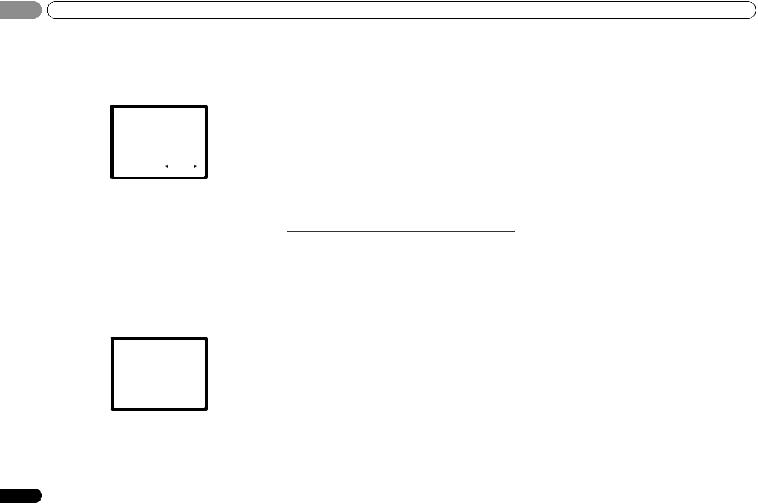
03 Basic Setup
•For correct speaker settings, do not adjust the volume during the test tones.
8 Confirm the speaker configuration.
The configuration shown on-screen should reflect the actual speakers you have.
1.Auto MCACC
Check!
Front |
[ |
YES ] |
||
Center |
[ |
YES ] |
||
Surr |
[ |
YES ] |
||
Surr. Back |
[YESx2] |
|||
Subwoofer |
[ |
YES ] |
||
|
|
|
|
|
10:Next |
|
|
OK |
|
|
|
Return |
||
•With error messages (such as Too much ambient noise) select RETRY after checking for ambient noise (see Other problems when using the Auto MCACC setup below).
If the speaker configuration displayed isn’t correct, use / to select the speaker and / to change the setting. When you’re finished, go to the next step.
If you see an error message (ERR) in the right side column, there may be a problem with the speaker connection. If selecting RETRY doesn’t fix the problem, turn off the power and check the speaker connections.
9 Make sure ‘OK’ is selected, then press ENTER.
If the screen in step 7 is left untouched for 10 seconds and ENTER is not pressed in step 8, the Auto MCACC setup will start automatically as shown.
1.Auto MCACC
Now Analyzing
Surround Analyzing
Speaker System
Speaker Distance
Channel Level
Acoustic Cal EQ
Return
A progress report is displayed on-screen while the receiver outputs more test tones to determine the optimum receiver settings for channel level, speaker distance, and Acoustic Calibration EQ.
Again, try to be as quiet as possible while this is happening. It may take 1 to 3 minutes.
24
10 The Auto MCACC setup has finished! You return to the System Setup menu.
The settings made in the Auto MCACC setup should give you excellent surround sound from your system, but it is also possible to adjust these settings manually using the System Setup menu (starting on page 37).
 Note
Note
•Depending on the characteristics of your room, sometimes identical speakers with cone sizes of around 12 cm (5 inches) will end up with different size settings. You can correct the setting manually using the Speaker Setting on page 37.
•The subwoofer distance setting may be farther than the actual distance from the listening position. This setting should be accurate (taking delay and room characteristics into account) and generally does not need to be changed.
Other problems when using the Auto MCACC setup
If the room environment is not optimal for the Auto MCACC setup (too much background noise, echo off the walls, obstacles blocking the speakers from the microphone) the final settings may be incorrect. Check for household appliances (air conditioner, fridge, fan, etc.), that may be affecting the environment and switch them off if necessary. If there are any instructions showing in the front panel display, please follow them.
•Some older TVs may interfere with the operation of the microphone. If this seems to be happening, switch off the TV when doing the Auto MCACC setup.
En
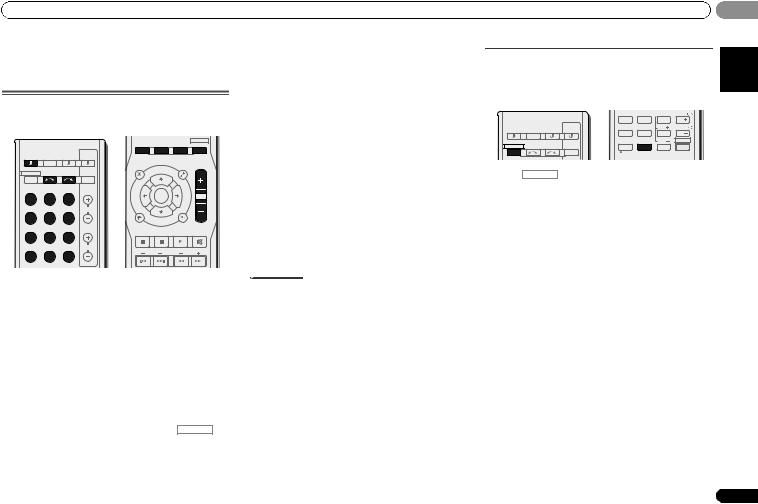
Basic playback |
0404 |
Chapter 4:
Basic playback
Playing a source
Here are the basic instructions for playing a source (such as a DVD disc) with your home theater system.
|
AUTO/ |
|
ALC/ |
BD MENU |
|
DIRECT |
STEREO STANDARD |
ADV SURR |
|
RECEIVER SLEEP SOURCE |
TV |
|
|
|
CONTROL |
|
|
MASTER |
|
|
AUDIO |
|
TUNER EDIT |
|
|
PARAMETER |
|
TOOLS |
VOLUME |
RECEIVER INPUT SELECT |
TOP |
TUNE |
MENU |
|
|
|
|||
|
MENU |
|
|
|
|
INPUT |
|
|
|
BD |
DVD |
TV |
T |
|
P |
E |
|
R |
|||
|
|
|
S |
ENTER |
E |
|
|
|
E |
S |
|
|
|
|
P |
|
E |
|
|
|
R |
|
T |
|
|
|
|
|
|
DVR/BDR |
CD |
CD-R |
CH |
|
|
|
|
|
HOME |
|
|
|
|
|
MENU |
TUNE |
|
|
|
|
SETUP |
BAND |
|
ADAPTER iPod USB |
VIDEO1 |
iPod CTRL |
|
RETURN |
|
CATEGORY |
DTV/ TV MUTE |
||||
|
|
|
|
|
|
VIDEO2 |
TUNER |
SIRIUS |
VOL |
|
|
|
|
|
|
BASS |
TRE |
1 Switch on your system components and receiver.
Start by switching on the playback component (for example a DVD player), your TV and subwoofer (if you have one), then the receiver (press RECEIVER).
• Make sure the setup microphone is disconnected.
2Switch the TV input to the input that connects this receiver.
For example, if you connected this receiver to the VIDEO jacks on your TV, make sure that the VIDEO input is now selected.
3Press input function buttons to select the input function you want to play.
•The input of the receiver will switch over, and you will be able to operate other components using the remote control. To operate the receiver, first press RECEIVER on the remote control, then press the appropriate button to operate.
•The input source can also be selected by using INPUT
SELECT  buttons on the remote control, or by using the front panel INPUT SELECTOR dial. In this case, the remote control won’t switch operational modes.
buttons on the remote control, or by using the front panel INPUT SELECTOR dial. In this case, the remote control won’t switch operational modes.
If you selected the proper input source and there is still no sound, select the audio input signal for playback (see
Selecting the audio input signal below).
4 Press AUTO/DIRECT to select ‘AUTO SURROUND’ and start playback of the source.
If you’re playing a Dolby Digital or DTS surround sound DVD disc, with a digital audio connection, you should hear surround sound. If you’re playing a stereo source or if the connection is an analog audio connection, you will only hear sound from the front left/right speakers in the default listening mode.
It is possible to check on the front panel display whether or not surround sound playback is being performed properly. When using a surround back speaker, 2D+PLIIx is displayed when playing Dolby Digital 5.1-channel signals, and DTS+NEO:6 is displayed when playing DTS 5.1-channel signals.
When not using a surround back speaker, 2D is displayed when playing Dolby Digital signals.
If the display does not correspond to the input signal and listening mode, check the connections and settings.
 Note
Note
•You may need to check the digital audio output settings on your DVD player or digital satellite receiver. It should be set to output Dolby Digital, DTS and 88.2 kHz/96 kHz PCM (2 channel) audio, and if there is an MPEG audio option, set this to convert the MPEG audio to PCM.
•Depending on your DVD player or source discs, you may only get digital 2 channel stereo and analog sound. In this case, the receiver must be set to a multichannel listening mode if you want multichannel surround sound.
5 Use MASTER VOLUME to adjust the volume level.
Turn down the volume of your TV so that all sound is coming from the speakers connected to this receiver.
Selecting the audio input signal |
|
|
|
English |
||
Once it is set, the audio input that was selected will be |
||||||
The audio input signal can be selected for each input source. |
|
|||||
applied whenever you select the input source using the input |
|
|||||
function buttons. |
|
|
|
|
Español |
|
|
|
7 |
8 |
9 |
CH |
|
|
|
S.RETRIEVER SB CH |
CH SELECT |
EQ |
|
|
|
|
4 |
5 |
6 |
CH |
|
|
TV |
MIDNIGHT SPEAKERS |
LEV |
PHASE |
|
|
RECEIVER SLEEP SOURCE CONTROL |
|
|
|
|
|
|
|
|
DIMMER SIGNAL SEL |
LEV |
SHIFT |
|
|
RECEIVER |
INPUT SELECT |
CLR |
0 |
ENTER |
|
|
|
INPUT |
/ +10 |
|
|
|
|
|
|
D.ACCESS |
|
|
|
|
Press |
RECEIVER , then press SIGNAL SEL to select the |
|
||||
audio input signal corresponding to the source component. |
|
|||||
Each press cycles through the following:
•H – Selects an HDMI signal. H can be selected for BD, DVD, DVR/BDR or VIDEO1 input. For other inputs, H cannot be selected.
-When the HDMI option in Setting the Audio options on page 35 is set to THRU, the sound will be heard through your TV, not from this receiver.
•A – Selects the analog inputs.
•C1/O1/O2 – Selects the digital input. The coaxial 1 input is selected for C1, and the optical 1 or 2 audio input is selected for O1 or O2.
When H (HDMI) or C1/O1/O2 (digital) is selected and the selected audio input is not provided, A (analog) is automatically selected.
 Note
Note
•VIDEO1 input is fixed to H (HDMI). It cannot be changed.
•For the TV/SAT input, only A (analog) or C1/O1/O2 (digital) can be selected. However, if the ARC at HDMI Setup is set to ON, the input is fixed to H (HDMI) and cannot be changed.
•When set to H (HDMI) or C1/O1/O2 (digital), 2lights when a Dolby Digital signal is input, and DTS lights when a DTS signal is input.
•When the H (HDMI) is selected, the A and DIGITAL indicators are off (see page 7).
25
En
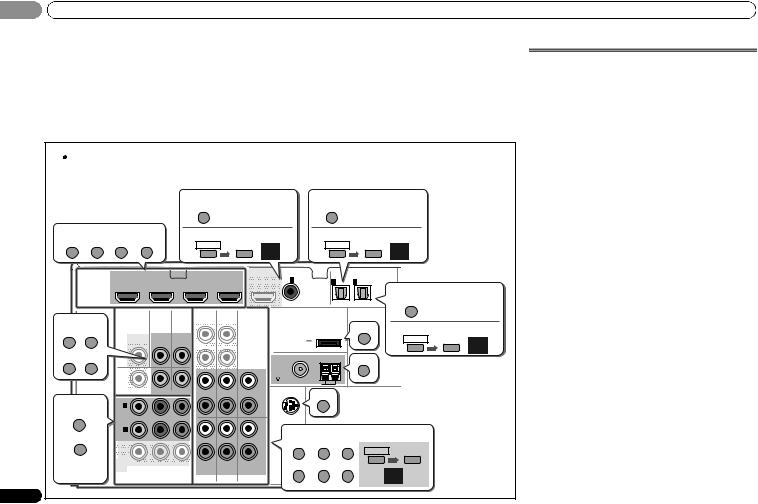
04 |
Basic playback |
|
|
• When digital input (optical or coaxial) is selected, this |
• You may get digital noise when a LD or CD player |
|
receiver can only play back Dolby Digital, PCM (32 kHz to |
compatible with DTS is playing an analog signal. To |
|
96 kHz) and DTS (including DTS 96 kHz/24 bit) digital |
prevent noise, make the proper digital connections |
|
signal formats. The compatible signals via the HDMI |
(page 13) and set the signal input to C1/O1/O2 (digital). |
|
terminals are: Dolby Digital, DTS, SACD (DSD 2 ch only), |
• Some DVD players don’t output DTS signals. For more |
|
PCM (32 kHz to 192 kHz sampling frequencies), Dolby |
details, refer to the instruction manual supplied with your |
|
TrueHD, Dolby Digital Plus, DTS-EXPRESS, DTS-HD |
DVD player. |
|
Master Audio and DVD Audio (including 192 kHz). With |
|
|
other digital signal formats, set to A (analog). |
|
 Tip
Tip
•In order to enjoy the picture and/or sound from devices connected to each terminal, select the input by doing the following.
|
|
|
|
|
Audio |
|
|
|
|
|
Audio |
|
|
|
|
|
||
|
|
|
|
|
1. |
CD |
|
|
|
|
|
1. |
TV |
(TV/SAT input) |
|
|
||
|
|
|
|
|
|
(CD input) |
|
|
|
|
|
|
|
|||||
Video/Audio (HDMI) |
|
|
2. Other than CD input |
|
|
2. Other than TV/SAT input |
|
|
||||||||||
DVR/BDR |
DVD |
BD |
VIDEO 1 |
|
|
|
|
|||||||||||
|
RECEIVER |
|
SIGNAL SEL |
C1 |
|
|
RECEIVER |
SIGNAL SEL |
O1 |
|
|
|||||||
|
|
|
|
|
|
|
|
|
|
|
||||||||
|
|
|
|
|
|
|
|
0 |
|
|
|
|
0 |
|
|
|||
HDMI |
DVR/BDR IN |
DVD IN |
|
|
|
|
|
|
|
|
|
|
|
|
|
|
||
|
|
|
|
|
|
|
|
|
|
|
ASSIGNABLE |
|
|
Audio |
|
|
||
|
|
|
|
|
|
|
|
|
|
|
|
|
|
|
|
|
|
|
|
|
|
|
|
|
|
|
|
|
|
(CD) |
|
(TV/SAT) (CD-R/TAPE |
1. CD-R |
|
|
||
|
|
|
|
|
|
AUDIO |
|
|
|
|
|
|
|
|
|
(CD-R input) |
|
|
Video |
|
|
|
|
|
|
|
|
|
|
|
|
|
|
|
|
|
|
|
|
|
|
|
DVR/BDR CD-R/TAPE |
|
|
|
|
|
|
ADAPTER |
2. Other than CD-R input |
|||||
TV |
BD |
|
|
TV/SAT |
BD |
|
|
L |
|
|
ADAPTER PORT |
|||||||
|
|
|
|
|
|
|
RECEIVER |
SIGNAL SEL |
|
|||||||||
|
|
|
|
|
|
|
|
(OUTPUT 5 V |
|
|
|
|
|
|||||
|
|
|
|
IN |
IN |
OUT |
|
|
|
|
|
|
|
O2 |
||||
|
|
|
|
|
|
|
|
0.1A MAX) |
|
|
|
|
|
0 |
||||
|
|
|
|
|
|
|
|
|
|
|
|
|
|
|
||||
DVR/BDR |
DVD |
|
|
|
|
|
|
R |
|
ANTENNA |
|
|
|
TUNER |
|
|
|
|
|
|
|
|
|
|
|
|
CD |
|
|
|
|
|
|
|
|
|
|
|
|
|
|
|
|
|
|
|
FM UNBAL |
|
|
|
|
|
|
|
||
|
|
|
|
|
|
|
|
|
|
|
|
|
|
|
|
|
||
|
|
|
|
|
|
|
|
|
L |
75 |
AM LOOP |
|
|
|
|
|
|
|
|
|
|
|
|
|
|
|
|
|
|
|
|
|
|
|
|
||
|
|
OUT |
IN |
DVD IN |
IN |
|
|
IN |
SIRIUS |
SIRIUS |
|
|
|
|
|
|||
Video |
|
|
|
|
|
|
|
|
|
|
|
|
|
|
|
|
||
|
IN 1 |
|
|
|
|
|
|
R |
|
|
|
|
|
|
|
|
|
|
|
|
|
|
|
|
|
|
|
|
|
|
|
|
|
|
|
||
DVR/BDR |
(DVD) |
|
|
|
|
|
|
|
|
|
|
|
|
|
|
|
|
|
ASSIGNABLE |
|
|
|
|
|
|
|
IN |
|
|
|
|
|
|
|
|||
|
|
|
|
|
|
|
|
|
|
|
|
|
|
|
|
|||
|
|
IN 2 |
|
|
|
|
|
|
L |
|
Audio |
|
|
|
|
|
|
|
|
|
(DVR/ |
|
|
|
|
|
|
|
|
|
|
|
|
|
|
|
|
DVD |
BDR) |
|
|
|
IN |
|
|
IN |
|
DVR/BDR |
CD-R |
CD |
|
|
|
|||
|
|
|
|
|
|
|
|
|
|
|
|
|
|
|||||
|
|
|
|
|
|
|
|
|
R |
|
|
|
|
|
RECEIVER |
SIGNAL SEL |
|
|
Reassignable |
MONITOR |
|
|
|
|
|
|
|
|
TV |
BD |
DVD |
0 |
|
|
|||
|
|
|
|
|
|
|
|
|
|
|
||||||||
(page 39) |
OUT |
Y |
PB |
PR |
TV/SAT |
BD |
DVD |
|
|
A |
|
|
||||||
|
|
|
|
|
|
|
|
|
|
|||||||||
|
|
COMPONENT VIDEO |
|
|
|
|
|
|
|
|
|
|
|
|
||||
26
Playing an iPod
This receiver has a dedicated iPod terminal that will allow you to control playback of audio content from your iPod using the controls of this receiver.
 Important
Important
•Pioneer cannot under any circumstances accept responsibility for any direct or indirect loss arising from any inconvenience or loss of recorded material resulting from the iPod failure.
 Note
Note
•This receiver is compatible with the audio and the video of the iPod nano, iPod (fifth generation), iPod classic, iPod touch and iPhone (only supports iPod (fifth generation) and iPod nano (first and second generation) audio playback) (iPod shuffle not supported). However, that some of the functions may be restricted for some models.
•This receiver has been developed and tested for the software version of iPod/iPhone/iPad indicated on the website of Pioneer.
•Installing software versions other than indicated on the website of Pioneer to your iPod/iPhone/iPad may result in incompatibility with this receiver.
•iPod and iPhone are licensed for reproduction of noncopyrighted materials or materials the user is legally permitted to reproduce.
•Features such as the equalizer cannot be controlled using this receiver, and we recommend switching the equalizer off before connecting.
1Switch on the receiver and your TV.
See Connecting an iPod on page 21.
2Switch the TV input so that it connects to the receiver.
3Press iPod USB on the remote control to switch the receiver to the iPod USB input.
The front panel display shows Loading while the receiver verifies the connection and retrieves data from the iPod.
4Use TOP MENU to display iPod Top menu.
When the display shows Top Menu you’re ready to play music from the iPod.
En
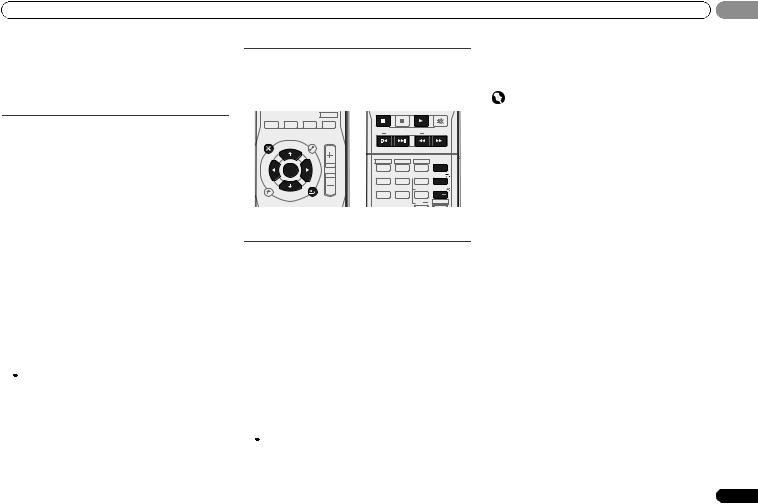
Basic playback |
0404 |
•If after pressing iPod the display shows NO DEVICE, try switching off the receiver and reconnecting the iPod to the receiver.
•The controls of your iPod (excluding the iPod touch and iPhone) will be inoperable when connected to this receiver (Pioneer shows in the iPod display).
Playing back files stored on an iPod
To navigate songs on your iPod, you can take advantage of the OSD of your TV connected to this receiver. You can also control all operations for music in the front panel display of this receiver.
•Note that non-roman characters in the title are displayed as ‘*’.
•This feature is not available for photos or video clips on your iPod.
Finding what you want to play
When your iPod is connected to this receiver, you can browse songs stored on your iPod by playlist, artist, album name, song name, genre or composer, similar to using your iPod directly.
1Use / to select a category, then press ENTER to browse that category.
•To return to the previous level any time, press RETURN.
2Use / to browse the selected category (e.g., albums).
•Use / to move to previous/next levels.
3Continue browsing until you arrive at what you want to play, then press to start playback.
 Tip
Tip
•If you’re in the song category, you can also press ENTER to start playback.
•You can play all of the songs in a particular category by selecting the All item at the top of each category list. For example, you can play all the songs by a particular artist.
Basic playback controls
This receiver’s remote control buttons can be used for basic playback of files stored on an iPod.
•Press iPod USB to switch the remote control to the iPod/ USB operation mode.
AUTO/ |
|
ALC/ |
BD MENU |
|
|
DTV/ TV |
MUTE |
DIRECT |
STEREO |
STANDARD |
ADV SURR |
|
|
|
|
AUDIO |
|
TUNER EDIT |
MASTER |
BASS |
TRE |
||
|
|
|
|
|
|||
PARAMETER |
|
TOOLS |
VOLUME |
|
|
|
|
TOP |
TUNE |
MENU |
|
|
|
|
|
|
|
|
|
|
MEMORY |
||
|
|
|
|
|
|
||
MENU |
|
|
|
|
|
|
|
T |
|
P |
|
HDD |
DVD |
VCR |
|
|
|
|
|
|
|
||
E |
|
R |
|
1 |
2 |
3 |
DISP |
S |
ENTER |
E |
|
||||
E |
S |
|
|
|
|
|
|
R |
|
E |
|
S.RETRIEVER |
SB CH |
CH SELECT |
EQ |
P |
|
T |
|
||||
|
|
|
|
4 |
5 |
6 |
CH |
HOME |
|
|
|
MIDNIGHT SPEAKERS |
LEV |
PHASE |
|
MENU |
TUNE |
|
|
7 |
8 |
9 |
CH |
SETUP |
BAND |
||||||
iPod CTRL |
|
RETURN |
|
DIMMER SIGNAL SEL |
LEV |
SHIFT |
|
CATEGORY |
|
|
|
|
|
|
|
•During Audiobook playback, press / to switch the playback speed: Faster Normal Slower
Watching photos and video content
To view photos or video on your iPod, since video control is not possible using this receiver, you must use the main controls of your iPod instead.
 Important
Important
•iPod photos and video content can be viewed only when the iPod is connected to the iPod VIDEO input on the front panel.
•This feature can only be used with an iPod having video output.
1Press iPod CTRL to switch to the iPod controls for photo and video playback.
The receiver controls will be unavailable while you are watching iPod videos or browsing photos.
2Press iPod CTRL again to switch back to the receiver controls when you’re done.
 Tip
Tip
•Change the receiver’s input to the iPod in one action by pressing iPod iPhone iPad DIRECT CONTROL on the
front panel to enable iPod operations on the iPod.
|
|
English |
|
Playing a USB device |
|||
|
|||
It is possible to listen to two-channel audio using the USB |
|
||
interface on the front of this receiver. |
|
||
Important |
|
||
Español |
|||
assumes no responsibility for any loss of data that may |
|||
• Pioneer cannot guarantee compatibility (operation and/ |
|
||
or bus power) with all USB mass storage devices and |
|
||
occur when connected to this receiver. |
|
||
|
|||
 Note
Note
•This includes playback of WMA/MP3/MPEG-4 AAC files (except files with copy-protection or restricted playback).
•Compatible USB devices include external magnetic hard drives, portable flash memory (particularly keydrives) and digital audio players (MP3 players) of format FAT16/32. It is not possible to connect this receiver to a personal computer for USB playback.
•With large amounts of data, it may take longer for the receiver to read the contents of a USB device.
•If the file selected cannot be played back, this receiver automatically skips to the next file playable.
•When the file currently being played back has no title assigned to it, the file name is displayed in the OSD instead; when neither the album name nor the artist name is present, the row is displayed as a blank space.
•Note that non-roman characters in the playlist are displayed as ‘*’.
•Make sure the receiver is in standby when disconnecting the USB device.
1Switch on the receiver and your TV.
See Connecting a USB device on page 22.
2Switch the TV input so that it connects to the receiver.
3Press iPod USB on the remote control to switch the receiver to the iPod USB input.
Loading appears in the OSD as this receiver starts recognizing the USB device connected. After the recognition, a playback screen appears in the OSD and playback starts automatically.
27
En

04 Basic playback
Basic playback controls
This receiver’s remote control buttons can be used for basic playback of files stored on USB devices.
•Press iPod USB to switch the remote control to the iPod/ USB operation mode.
AUTO/ |
|
ALC/ |
BD MENU |
DIRECT |
STEREO |
STANDARD |
ADV SURR |
AUDIO |
|
TUNER EDIT |
MASTER |
PARAMETER |
|
TOOLS |
VOLUME |
TOP |
TUNE |
MENU |
|
|
|
||
MENU |
|
|
|
T |
|
P |
|
E |
|
R |
|
S |
ENTER |
E |
|
E |
S |
|
|
P |
|
E |
|
R |
|
T |
|
|
|
|
|
HOME |
|
|
|
MENU |
TUNE |
|
|
SETUP |
BAND |
||
iPod CTRL |
|
RETURN |
|
CATEGORY
 Important
Important
|
|
DTV/ TV |
MUTE |
BASS |
TRE |
||
|
|
|
MEMORY |
HDD |
DVD |
VCR |
|
1 |
2 |
3 |
DISP |
S.RETRIEVER |
SB CH |
CH SELECT |
EQ |
4 |
5 |
6 |
CH |
MIDNIGHT SPEAKERS |
LEV |
PHASE |
|
7 |
8 |
9 |
CH |
DIMMER SIGNAL SEL |
LEV |
SHIFT |
|
If a USB Error message lights in the display, try following the points below:
•Switch the receiver off, then on again.
•Reconnect the USB device with the receiver switched off.
•Select another input source (like BD), then switch back to iPod USB.
•Use a dedicated AC adapter (supplied with the device) for USB power.
For more information on error messages, see USB messages on page 50.
If this doesn’t remedy the problem, it is likely your USB device is incompatible.
28
Compressed audio compatibility
Note that although most standard bit/sampling rate combinations for compressed audio are compatible, some irregularly encoded files may not play back. The list below shows compatible formats for compressed audio files:
•MP3 (MPEG-1/2/2.5 Audio Layer 3) – Sampling rates:
8 kHz to 48 kHz; Bit rates: 8 kbps to 320 kbps (128 kbps or higher recommended); File extension: .mp3
•WMA (Windows Media Audio) – Sampling rates: 32 kHz/ 44.1 kHz; Bit rates: 32 kbps to 192 kbps (128 kbps or higher recommended); File extension: .wma; WMA9 Pro and WMA lossless encoding: No
•AAC (MPEG-4 Advanced Audio Coding) – Sampling rates: 11.025 kHz to 48 kHz; Bit rates: 16 kbps to 320 kbps (128 kbps or higher recommended); File extension: .m4a; Apple lossless encoding: No
Other compatibility information
•VBR (variable bit rate) MP3/WMA/MPEG-4 AAC playback: Yes (Note that in some cases playback time will not be displayed correctly.)
•DRM (Digital Rights Management) protection compatible: Yes (DRM-protected audio files will not play in this receiver.)
About MPEG-4 AAC
Advanced Audio Coding (AAC) is at the core of the MPEG-4 AAC standard, which incorporates MPEG-2 AAC, forming the basis of the MPEG-4 audio compression technology. The file format and extension used depend on the application used to encode the AAC file. This receiver plays back AAC files encoded by iTunes® bearing the extension ‘.m4a’. DRMprotected files will not play, and files encoded with some versions of iTunes® may not play.
Apple and iTunes are trademarks of Apple Inc., registered in the U.S. and other countries.
About WMA
WMA is an acronym for Windows Media Audio and refers to an audio compression technology developed by Microsoft Corporation. This receiver plays back WMA files encoded using Windows Media® Player bearing the extension ‘.wma’. Note that DRM-protected files will not play, and files encoded with some versions of Windows Media® Player may not play.
Bluetooth® ADAPTER for Wireless Enjoyment of Music
Bluetooth wireless technology enabled device: cell phone
Bluetooth wireless technology enabled device:
Digital music player
Device not equipped with Bluetooth wireless technology: Digital music player + Bluetooth audio transmitter (sold commercially)
Music data |
Bluetooth® |
|
ADAPTER |
||
|
This receiver |
Remote control |
operation |
Wireless music play
When the Bluetooth ADAPTER (Pioneer Model No. AS-BT100 or AS-BT200) is connected to this unit, a product equipped with Bluetooth wireless technology (portable cell phone, digital music player, etc.) can be used to listen to music wirelessly. Also, by using a commercially available transmitter supporting Bluetooth wireless technology, you can listen to music on a device not equipped with Bluetooth wireless technology. The AS-BT100 and AS-BT200 model supports SCMS-T contents protection, so music can also be enjoyed on devices equipped with SCMS-T type Bluetooth wireless technology.
•It must be necessary that the Bluetooth wireless technology enabled device supports A2DP profiles.
En

Basic playback
 Important
Important
•Pioneer does not guarantee proper connection and operation of this unit with all Bluetooth wireless technology enabled devices.
Remote control operation
The remote control supplied with this unit allows you to play and stop media, and perform other operations.
•It must be necessary that the Bluetooth wireless technology enabled device supports AVRCP profiles.
•Remote control operations cannot be guaranteed for all Bluetooth wireless technology enabled devices.
Pairing the Bluetooth ADAPTER and Bluetooth wireless technology device
“Pairing” must be done before you start playback of Bluetooth wireless technology content using Bluetooth ADAPTER. Make sure to perform pairing first time you operate the system or any time pairing data is cleared. “Pairing” is the step necessary to register Bluetooth wireless technology device to enable Bluetooth communications. For more details, see also the operating instructions of your Bluetooth wireless technology device.
•Pairing is required when you first use Bluetooth wireless technology device and Bluetooth ADAPTER.
•To enable Bluetooth communication, pairing should be done with both of your system and Bluetooth wireless technology device.
•If the Bluetooth wireless technology device’s security code is “0000”, there is no need to make the security code setting on the receiver. Press ADAPTER to switch the ADAPTER input, then conduct the pairing operation on the Bluetooth wireless technology device. If pairing is successful, there is no need to performing the pairing operation below.
•When using the AS-BT200 only: If the Bluetooth wireless technology device supports SSP (Secure Simple Pairing), there is no need to make the security code setting. Press ADAPTER to switch the ADAPTER input, then conduct the pairing operation on the Bluetooth wireless technology device. If pairing is successful, there is no need to performing the pairing operation below.
1Press TOP MENU.
2Press ENTER to enter PAIRING.
3Select the PIN code to be used from 0000/1234/8888 using /, then press ENTER.
PAIRING blinks.
•You can use any of 0000/1234/8888 PIN codes. Bluetooth wireless technology device using any other PIN code cannot be used with this system.
4Switch on the Bluetooth wireless technology device that you want to make pairing, place it near the system and set it into the pairing mode.
5Check to see that the Bluetooth ADAPTER is detected by the Bluetooth wireless technology device.
When Bluetooth wireless technology device is connected:
Bluetooth wireless technology device name appears in the receiver display.
•The system can display alphanumeric characters only. Other characters may not be displayed correctly.
When Bluetooth wireless technology device is not connected:
NODEVICE appears in the receiver display. In this case, perform the connection operation from the side of the Bluetooth wireless technology device.
6 From the Bluetooth wireless technology device list, select Bluetooth ADAPTER and enter the PIN code selected in the step 4.
• PIN code may in some case be referred to as PASSKEY.
Listening to Music Contents of Bluetooth wireless technology device with Your System
1Press ADAPTER to switch the receiver to ADAPTER input.
The ADAPTER input can also be selected by pressing SOUND RETRIEVER AIR on the front panel. In this case, S.R AIR, the optimum listening mode, is selected automatically.
2Perform the connection operation from the side of the Bluetooth wireless technology device to the Bluetooth ADAPTER.
•When the Bluetooth ADAPTER is not plugged into the
ADAPTER PORT terminal, NO ADAPTER will be displayed if ADAPTER input is selected.
|
|
|
|
|
|
|
0404 |
|
3 Start playback of music contents stored in Bluetooth |
|
|
||||||
|
English |
|||||||
playback of files stored on the Bluetooth wireless technology |
|
|||||||
wireless technology device. |
|
|
|
|
|
|||
This receiver’s remote control buttons can be used for basic |
|
|
||||||
device. |
|
|
|
|
|
|||
|
|
|
|
|
||||
• Bluetooth wireless technology device should be |
|
|||||||
Español |
||||||||
use, operation may differ from what is shown in the |
||||||||
compatible with AVRCP profile. |
|
|||||||
• Depending on Bluetooth wireless technology device you |
|
|||||||
remote control buttons. |
|
|
|
|
|
|||
|
|
|
|
|
||||
CATEGORY |
DTV/ TV MUTE |
|
||||||
|
|
|
|
|||||
|
|
|
|
|
|
|
|
|
|
|
|
|
|
|
|
|
|
|
|
|
|
|
|
|
|
|
BASS |
TRE |
|
||||||
MEMORY
The Bluetooth® word mark and logos are registered trademarks owned by Bluetooth SIG, Inc. and any use of such marks by Pioneer Corporation is under license. Other trademarks and trade names are those of their respective owners.
Listening to Satellite Radio
To listen to Satellite Radio, you’ll need to connect a SIRIUS Satellite Radio tuner (sold separately) to your Sirius-Ready receiver. SIRIUS Satellite Radio is available to residents of the US (except Alaska and Hawaii) and Canada.
Satellite Radio delivers a variety of commercial-free music from categories ranging from Pop, Rock, Country, R&B, Dance, Jazz, Classical and many more plus coverage of all the top professional and college sports including play by play games from select leagues and teams. Additional programming includes expert sports talk, uncensored entertainment, comedy, family programming, local traffic and weather and news from your most trusted sources. Once you’ve purchased a SIRIUS tuner you’ll need to activate it and subscribe to begin enjoying the service. Easy to follow installation and setup instructions are provided with the SIRIUS tuner. There are a variety of programming packages available, including the option of adding ‘The Best of XM’
29
En

04 Basic playback
programming to the SIRIUS service. The ‘Best of XM’ service is not available to SIRIUS Canada subscribers at this time. Please check with SIRIUS Canada for any updates using the numbers and web address below.
Family friendly packages are also available to restrict channels featuring content that may be inappropriate for children.
To subscribe to SIRIUS, U.S. and Canadian customers can call 1-888-539-SIRI (1-888-539-7474) or visit sirius.com (US) or siriuscanada.ca (Canada).
SIRIUS, XM and all related marks and logos are trademarks of Sirius XM Radio Inc. and its subsidiaries. All rights reserved.
Service not available in Alaska and Hawaii.
Listening to SIRIUS Radio
After connecting, you will be able to use this receiver to select channels using the front panel display.
 Note
Note
•In order to activate your radio subscription, you will need the SIRIUS ID (SID) which uniquely identifies your tuner. The SID may be found on a sticker located on the packaging, or on the bottom of the tuner itself. The label will have a printed 12-digit SID number. When you have located the SID, write it down in the space provided near the end of this manual. Connect SIRIUS on the internet at: https://activate.siriusradio.com
Follow the prompts to activate your subscription, or you can also call SIRIUS toll-free at 1-888-539-SIRIUS (1-888- 539-7474).
Press SIRIUS to switch to the SIRIUS input.
For best reception, you may need to move the SiriusConnect tuner antenna near a window (refer to the manual for the SiriusConnect Home tuner for antenna placement recommendations).
•If after pressing SIRIUS the display shows Antenna Error, try disconnecting the antenna and reconnecting. If the display shows Check Sirius Tuner, check the connection of the AC adapter and this receiver to the SiriusConnect tuner.
-You can check the strength of reception by pressing
DISP (DISPLAY).
30
Selecting channels and browsing by genre
Use the front panel display to select channels. You can select channels from your favorite genre.
•You can, however, use just the front panel display to do everything if you prefer.
Press / to select the channel. In the next 2 seconds, the radio broadcast is automatically tuned in.
•To select a channel from your favorite genre, press CATEGORY and use / to select a genre, and then use / and ENTER to select a channel from the selected genre.
-Select SR000 (SIRIUS ID) from the front panel display to check the Radio ID of the SIRIUS Connect tuner.
•To cancel and exit any time, press RETURN.
 Tip
Tip
•You can select channels directly by pressing D.ACCESS then the three-digit channel number.
•You can press DISP (DISPLAY) to change SIRIUS Radio information in the front panel display.
•The currently selected channel is automatically chosen (without pressing ENTER) after 2 seconds.
Saving channel presets
This receiver can memorize up to 30 channels, stored.
1 Select the channel you want to memorize.
See Selecting channels and browsing by genre above.
2 Press T.EDIT.
The display shows a blinking memory number.
3Press / to select the channel preset you want.
You can also use the number buttons to select a preset.
4Press ENTER.
After pressing ENTER, the preset number stop blinking and the receiver stores the SIRIUS channel.
Listening to channel presets
You will need to have some presets stored to do this.
Press / to select the channel preset you want.
•You can also use the number buttons on the remote control to recall the channel preset.
Using the SIRIUS Menu
The SIRIUS Menu provides additional SIRIUS Radio features.
1Press TOP MENU.
2Use / to select a menu item then press ENTER.
Choose between the following menu items:
•All CHANNEL SKIP CLEAR – Clear the channel skip function set by the SiriusConnect tuner. If the channel skip function is not cleared here, not all channels are displayed because this receiver stores the channels set for skipping in the SiriusConnect tuner.
•Parental Lock – Use /and ENTER to select channels you would like to place under parental lock. Channels put under parental lock are not displayed in the Channel Guide, but may be accessed by directly inputting their channel number and providing the parental lock password.
•Password Set – Set the parental lock password.
3When you’re finished press TOP MENU to return to the reception display.
•You can reset the channel presets, parental lock and Password Set in Resetting the main unit on page 50.
En
